
Affiliate disclosure: Some of the links included in this post are affiliate links. Affiliate links cost you nothing, but we may earn a small commission if you do book something. This costs no extra for you, and helps support the site.

Évora Portugal: The Ultimate Guide to Visiting Évora [2024]
Located approximately 130km to the east of Lisbon, Évora is the largest city of the Alentejo region and its designated capital. With a history that dates to Celtic times, Évora boasts a rich historical background. Being famous for its impressive Roman ruins, Gothic churches, and well-preserved historic centre which was inscribed on the UNESCO World Heritage List in 1986. Being somewhat off the beaten path, it’s also a great place to experience a slower pace of life and a more genuine Portugal. On top of that it’s also one of the best places to sample some traditional and incredible Alentejo food and wines.
A Brief Introduction on Évora’s History
Évora’s history goes all the way back to Celtic rule in the Iberian Peninsula, the name Evora derives from ancient Celtic word Ebora which means “of the yew trees”. During the Roman Period it was enclosed by walls, and substantially developed, receiving the honorary designation of Liberalitas Julia from Julius Caesar. This period is still evident in Évora, with the Roman temple being one of the focal points of the Alentejo city.

Afterwards, the city was occupied by the Visigoths and later by the Moors, the city walls were reworked, and the defensive system improved. In 1165, the city was reconquered by Gerald the Fearless – a famed Portuguese knight. Several buildings from the Medieval period still exist, one of the most prominent being the cathedral. Évora reached its golden age in 15th century after it became the place of residency of Portuguese royalty. At this time several religious buildings and royal palaces were constructed, in what would lead Évora to become Portugal’s second city.
What to See and Do in Évora
Evora’s narrow streets hide many pretty corners, public squares, and it’s a small enough to wonder and get lost in without having to worry about losing your bearings.

Mercado Municipal – Municipal Market of Évora
Our visit starts in Évora’s municipal market located at Praça 1º de Maio . Different from most mercados , this one consists of two constructions. A main building for local produce, cheeses, cured meat, bread, etc. And a separate smaller building exclusively for fresh fish.
The main section of the market was built in 1880, featuring a wrought-iron structure commissioned by Companhia Perseverança , like many other traditional markets across the country, symbolizing the 19 th century Portuguese iron architecture ( arquitetura do ferro ). The annexed fish market was built in 1903 inspired by the now demolished Mercado da Praça da Figueira in Lisbon. In 2005, both buildings were modernised to accommodate a total of 56 stalls, some of them accessible from the outside.

Nowadays, it also houses some restaurants and snack-bars, and even a tap room of Alentejo’s craft beer, Magnífica. Most of them with outdoor sitting, so it’s a lovely place to stop for refreshments. The atmosphere is even livelier on Saturdays, where farmers gather outside the market to sell their produce. And every second Sunday of the month, you can also shop antiques and collectors’ pieces. For those visiting during weekdays, just keep in mind that the market is closed on Mondays.
Pra ça do Giraldo – Giraldo ’s Square
Now we head further into the city’s historic center via Romão Ramalho Street towards Praça do Giraldo , our next stop. The 13th century square is named after Geraldo sem Pavor (Gerald the Fearless) a knight responsible for retaking several towns in the Alentejo region during the Christian reconquest. The most important and long lasting being the reconquest of Évora from Moorish rule in 1165.

The rectangular square is paved with the traditional calçada portuguesa in geometric patterns, and surrounded by buildings with matching stone façades, tall windows, and small wrought-iron balconies. On the eastern side of the square, some shops and restaurants are sheltered by an arcade with arches of different heights and sizes, including the historic Café Arcada.
One of the most important buildings of Praça do Giraldo is Igreja de Santo Antão , but other buildings are also worth mentioning such as 16 th century agency of Banco de Portugal (Portugal’s Central Bank) directly opposite the church, and the tourism office on the western side.

Fonte da Praça do Giraldo – Fountain of Giraldo’s Square
One of the focal points of the square is the Renaissance white marble fountain, Fonte da Praça do Giraldo. Built in 1571 it replaced a previous more rudimentary fountain from 1537 following the conclusion of the construction of the aqueduct Água das Pratas which ended on the fountain. The fountain has 8 pumps which are believed to symbolize the number of streets that connect the square with the rest of the city. Though nowadays the water is not deemed safe for consumption, it was for many centuries, one of the main sources of water in Évora.

Throughout the centuries, the square staged several social and cultural activities, including a daily market before the construction of the municipal market, and even bullfights. These days, it’s still a focal point for social interaction, and a lovely place to enjoy a cup of coffee and the slower pace of inland Portugal.
Catedral de Évora – Cathedral of Évora
Now it’s time to head to one of the most famous monuments of the city: the medieval Cathedral of Évora. It’s about a 3-minute walk from Praça do Giraldo, and you just have to head up Rua Cinco de Outubro , the narrow street on the east side of Praça do Giraldo sandwiched between the arches, as it will take you straight to the cathedral’s main entrance.

The fortified church is the largest medieval cathedral in Portugal, and one of the finest exemplars of the transition from the Romanesque to the Gothic style. It’s also known as Catedral de Santa Maria , as it is dedicated to the Virgin Mary. Its construction started in 1186, following the Christian reconquest of Évora, being consecrated in 1204, and only finished in 1250.
The main façade was built with pink granite bricks, featuring two main towers and a portal with Gothic sculptures of the Apostles sustained by marble columns decorated with floral patterns.

The interior of the church is just as grand as the exterior, with the imposing height of the central Gothic nave, and several pieces that deserve a closer look, such as the 16 th century organ commissioned by Heitor Lobo. And the main chapel in the Baroque style, contrasting with the main features of the church, with its beautiful altar in a mix of white, yellow, black, and pink marble.

Most visitors, however, are more interested in the rooftop of the church, to both take a closer look at the picturesque dome. And to appreciate stunning views of Évora and surroundings, including the nearby Roman temple – Templo de Diana . The entry fee is 4€, and it includes visiting the church, cloister, the rooftop, and the Sacred Art Museum in a connected annex.
Templo Romano de Évora – Templo de Diana
Once you exit the cathedral, turn right towards Largo do Conde de Vila Flor and you will see one of the finest symbols of the Roman presence in the Iberian Peninsula – the emblematic Roman Temple of Évora, or the ruins of it. Believed to date back to the 1 st century CE, the temple was dedicated to emperor Augustus, although until the 1990’s it was wrongly assumed it was built to honour the ancient goddess of the hunting, the moon and chastity – Diana. To present day the temple is still colloquially called Templo de Diana .

The temple was the centre of the main public square of Roman Évora, known as Liberalitas Iulia Ebora back in the day. The original temple was surrounded by a water tank believed to be connected to the aqueduct. Throughout the centuries, it was used in several different ways, going from a religious building to a fortified house, and later even a slaughterhouse. Its architecture also suffered several changes. Between the 14 th and 19 th centuries, its columns were enclosed by walls that were only demolished in 1971 when it was ordered that all non-roman features were to be removed.
The Roman temple is surrounded by many other significant buildings, such as the public library, Igreja dos Lóios , and National Museum of Friar Manuel do Cenáculo. Just opposite the temple there’s the lovely Jardim Diana , which is the perfect stop point for contemplating the temple, and yet another great place to get some refreshments from one of the kiosks nearby.
Aqueduto da Água da Prata
For those interested in diving deeper into Évora’s architecture, head to Rua do Cano on the lower part of Évora to check out Aqueduto da Água da Prata . It’s only a 10-minute walk from Praça do Giraldo. As you head there make sure you stop at Largo Luiz Camões, this way you get to see how the aqueduct is integrated into the historic downtown.
With an 18km extension, it was built in the 16 th century over what is believed to be the foundations of a Roman period aqueduct, which is assumed to be much higher. It was designed to take water to the highest part of city, where the temple and old forum were located. Supplying three main fountains, including Fonte da Praça do Giraldo, where the people of Évora would gather to collect water. The aqueduct is still operational to these days.

As you walk alongside the aqueduct in Rua do Cano , you will see that several arches have tiny yellow houses embedded in them. With a total of 30 buildings merged with the arches. We also recommend taking a look at the renaissance water tank in Rua Nova which is a couple of meters away from the main square.
Capela dos Ossos – Évora’s Bone Chapel
If you have already visited Mercado Municipal de Évora , you probably noticed Igreja de São Francisco just across the street. This Gothic-Manueline style church belongs to the convent of same name . Although less imposing than the city’s cathedral, it’s just as busy. In fact, those that don’t have much time often favour visiting Igreja de São Francisco over the city’s cathedral. That’s because it houses Portugal’s largest bone chapel.

With bones of approximately 5.000 people, the chapel was built in the late 16 th century by Franciscan monks. The chapel was built to clear out valuable lands across the city, back then being used as monastic graveyards. The monks then decided that displaying the bones would be a good way of meditating on the transience of life. This motive is clear in the message above the chapel entrance, which reads “ Nós ossos que aqui estamos pelos vossos esperamos ” literally meaning “We bones that are here, await for yours”.

Entrance fee is 6€ per person, and it includes visiting the chapel, museum, and seeing the collection of nativity scenes made by artists from all over the world.
Jardim Público de Évora
Not far from the municipal market, is the Public Garden of Évora. A 3-acre Romantic style garden laid out in 1863 by Italian architect Giuseppe Cinatti. It is another lovely place to take a break from sightseeing, as it offers plenty of shade, two kiosks for refreshments, and even a little park for children. With the bonus of colourful peacocks and ducks that live there. During spring the garden is even more lovely with wisterias, hydrangeas and bougainvilleas in full bloom.

The garden is also packed with monuments and historic buildings, such as the the 19 th century wrought iron bandstand. And the remaining segments of former royal residence Palacio de D. Manuel .
Amidst the trees of the garden, there are also the ‘fake ruins’ or Ruínas Fingídas, also a project of the original architect. These fabricated ruins have the city’s medieval wall as the main structure, combining Manueline style double windows retrieved from the demolished Paço Eborense dos Condes do Vimioso. Despite not being legitimate in their layout, this is a very picturesque construction playing into the Romantic style of the garden. It’s also loved by the peacocks that wonder around its walls and arches.

Traditional Pastries in Évora
Being the capital of the Alentejo region, Évora is a great place to try the so called doces conventuais, and some other traditional pastries unlikely to be found outside of Alentejo. In Praça do Giraldo you will find several pastelarias with a great variety of pastries and cakes, and of course the celebrated pastel de nata. If you feel like stepping out of your pastry comfort zone, we recommend you try pão de rala. On the outside it resembles a crusty bread roll, but once you take a bite you are surprised with a very moist filling made of eggs, sugar, almonds, lemon zest and gila – a type of squash loved by the Portuguese. Our favorite place to go for a coffee and a pastry is Gema d’Évora , but we also recommend its neighbour Café Arcada, both located at Praça do Giraldo .

Organised Tours to Évora
At just over an hour from Lisbon, it’s a popular day trip and makes a great alternative to the more typically recommended Sintra and Óbidos. Several tours are available that will take you to nearby Monsaraz, or a vineyard, before returning you to Lisbon – a great way to sample the Alentejo region! Most of these are large group tours, or coach trips that will start in Lisbon and bring you back in the same day, but if you’re willing to up your budget you’ll find private options as well! For those already in Évora, then a great addition to your trip is a cork tour, taking you out into the nearby forests to show you how cork is harvested, and processed. A great insight into locale industry.

Here’s our pick of our favourite and best reviewed tours:
- From Lisbon: Évora and Monsaraz Day Tour with Wine Tasting (€97 per person)
- Cork Safari in a Classic Land Rover with Optional Lunch (€80 per person)
- Évora Full-Day Tour with Wine Tasting from Lisbon (€500 per group)
Somewhere to Stay in Évora
Évora is definitely more of traditional town than a tourist destination compared to the Algarve or Lisbon. However, you’ll still find plenty of good options for overnight stays, and even longer if you wish! For a luxurious stay within the walls we recommend the Évora Olive hotel . More budget travellers can take a look at the Hotel Ibis Evora , just a short walk outside the walls it’s a solid option if you’re not fussy about the amenities and you just want to explore the town! You can take a look at the full range of options in Évora with this list here!

Should You Visit Évora
Évora is a fantastic town to visit, and even base yourself in to explore the serene Alentejo . Surrounded by authentic sites, and the incredible local food, Évora makes a good day trip, or a great stopping point for longer trips. For travellers making their way between Lisbon and the Algarve we recommend at least taking the inland route with a stop in Évora for one of your directions of travel.
Leave a Comment Cancel reply
Évora Printable Tourist Map
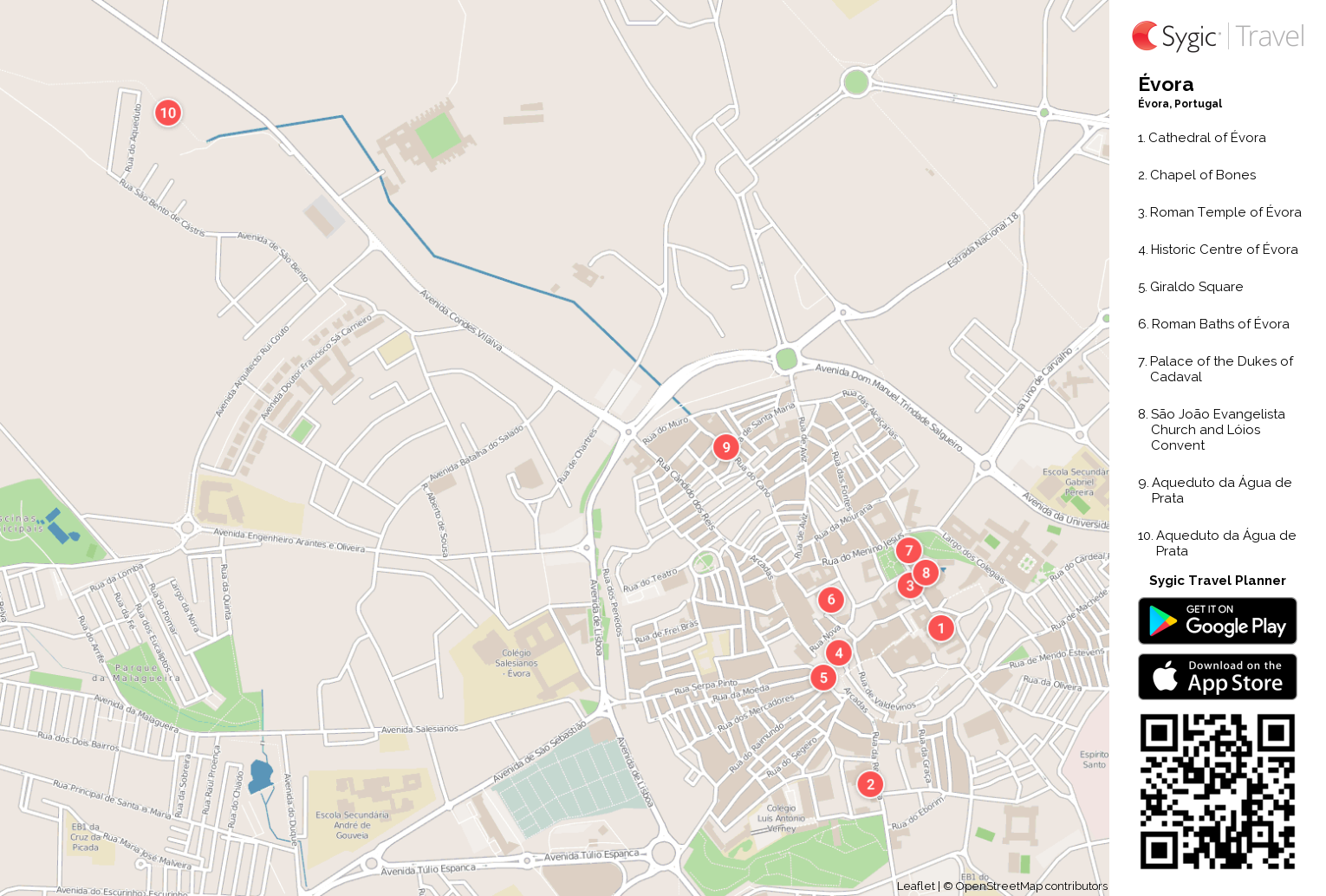
Évora Map: The Attractions

Roman Temple of Évora
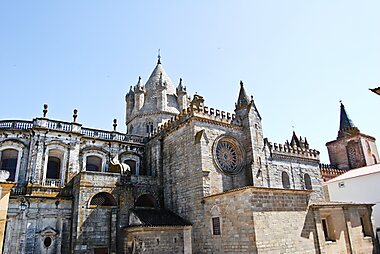
Cathedral of Évora
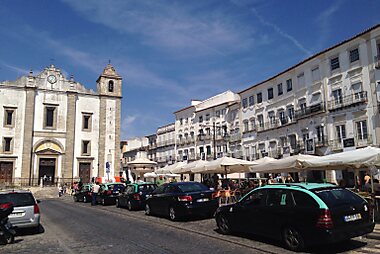
Giraldo Square
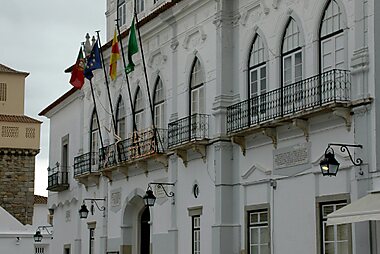
Roman Baths of Évora

Royal Palace of Évora
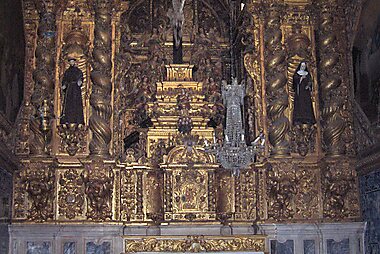
Igreja de São Francisco
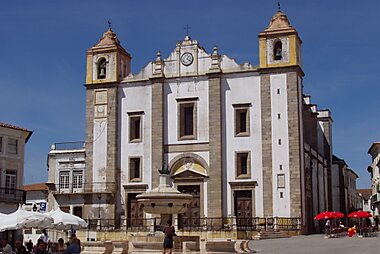
Historic Centre of Évora
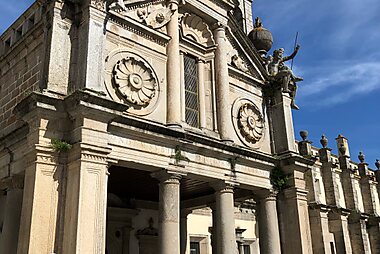
Igreja da Graça
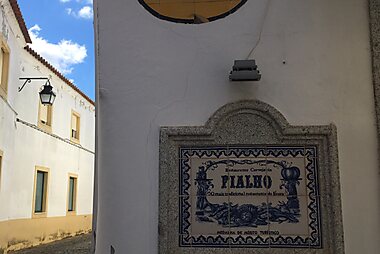
Portas de Aviz
Sygic travel - a travel guide in your pocket.

More Tourist Maps
- Privacy Policy
- STOCK 360° TRAVEL VIDEOS
Map of Evora — Best attractions, restaurants, and transportation info
What’s on this map.
We’ve made the ultimate tourist map of Evora, Portugal for travelers! Check out Evora’s top things to do, attractions, restaurants, and major transportation hubs all in one interactive map.
Visiting Evora? See our Evora Trip Planner.
How to use the map
Use this interactive map to plan your trip before and while in Evora. Learn about each place by clicking it on the map or read more in the article below. Here’s more ways to perfect your trip using our Evora map:
- Explore the best restaurants, shopping, and things to do in Evora by categories
- Get directions in Google Maps to each place
- Export all places to save to your Google Maps
- Plan your travels by turning on metro and bus lines
- Create a Wanderlog trip plan (link to create a trip plan for the city) that keep all the places on the map in your phone
- Print a physical map to bring it on your trip

Top 18 attractions in Evora
Chapel of bones (évora), templo romano évora.
Navigate forward to interact with the calendar and select a date. Press the question mark key to get the keyboard shortcuts for changing dates.
Navigate backward to interact with the calendar and select a date. Press the question mark key to get the keyboard shortcuts for changing dates.

Museum Frei Manuel do Cenáculo
Almendres cromlech, university of évora, cathedral of évora, praça do giraldo, enoturismo cartuxa, jardim diana, igreja de são joão evangelista / igreja dos lóios, ruínas fingidas, dona dorinda organic wines, igreja e mosteiro de são francisco, hotel m'ar de ar muralhas, convento do espinheiro, historic hotel & spa - évora, centro interpretativo dos almendres, frescos das casas pintadas, top 10 restaurants in evora, taberna típica quarta-feira, tábua do naldo, vinho e noz, botequim da mouraria, momentos évora, dom joaquim, café alentejo, transportation in evora, nearby airports, aeroporto de beja, highways and major roads.
- A6 - connects Evora to Lisbon
- N18 - main road through Evora, from Estremoz to Montemor-o-Novo
- N114 - connects Evora to Reguengos de Monsaraz
- N381 - connects Evora to Redondo and Mourão
- N242 - connects Evora to Viana do Alentejo
- N254 - connects Evora to Serpa and Beja
- N255 - connects Evora to Alandroal and Vila Viçosa
- N256 - connects Evora to Portel and Moura
- N371 - connects Evora to Alvito and Cuba
- N372 - connects Evora to Arraiolos and Montemor-o-Novo.
Attractions

Top searches in Evora
Popular road trips from evora, what's the weather like in evora.
It depends on when you visit! We've compiled data from NASA on what the weather is like in Evora for each month of the year: see the links below for more information.
- Weather in Evora in January
- Weather in Evora in February
- Weather in Evora in March
- Weather in Evora in April
- Weather in Evora in May
- Weather in Evora in June
- Weather in Evora in July
- Weather in Evora in August
- Weather in Evora in September
- Weather in Evora in October
- Weather in Evora in November
- Weather in Evora in December
All road trips from Evora
- Evora to Lisbon drive
- Evora to Madrid drive
- Evora to Barcelona drive
- Evora to Paris drive
- Evora to London drive
- Evora to Seville drive
- Evora to Rome drive
- Evora to Porto drive
- Evora to Amsterdam drive
- Evora to Cordoba drive
- Evora to Granada drive
- Evora to Valencia drive
- Evora to Albufeira drive
- Evora to Marrakech drive
- Evora to Florence drive
- Evora to Berlin drive
- Evora to Prague drive
- Evora to Malaga drive
- Evora to Milan drive
- Evora to Edinburgh drive
- Evora to Venice drive
- Evora to Dublin drive
- Evora to Vienna drive
- Evora to Toledo drive
- Evora to Merida drive
- Evora to Brussels drive
- Evora to Salamanca drive
- Evora to Coimbra drive
- Evora to Sintra drive
Explore nearby places
- Viana do Alentejo
- Montemor-o-Novo
- Vila Nova da Baronia
- Reguengos de Monsaraz
- Sao Pedro do Corval
- Vila de Frades
- Casa Branca
All related maps of Evora
- Map of Igrejinha
- Map of Sao Mancos
- Map of Arraiolos
- Map of Azaruja
- Map of Escoural
- Map of Evoramonte
- Map of Viana do Alentejo
- Map of Montemor-o-Novo
- Map of Sabugueiro
- Map of Alcacovas
- Map of Vimieiro
- Map of Redondo
- Map of Vila Nova da Baronia
- Map of Portel
- Map of Alvito
- Map of Reguengos de Monsaraz
- Map of Pavia
- Map of Ciborro
- Map of Gloria
- Map of Sao Pedro do Corval
- Map of Brotas
- Map of Vila de Frades
- Map of Vidigueira
- Map of Estremoz
- Map of Torrao
- Map of Casa Branca
- Map of Cabecao
- Map of Cuba
- Map of Lavre
- Map of Mora
Evora throughout the year
- Evora in January
- Evora in February
- Evora in March
- Evora in April
- Evora in May
- Evora in June
- Evora in July
- Evora in August
- Evora in September
- Evora in October
- Evora in November
- Evora in December
Looking for day-by-day itineraries in Evora?
Get inspired for your trip to Evora with our curated itineraries that are jam-packed with popular attractions everyday! Check them out here:
- 1-Day Evora Itinerary
- 2-Day Evora Itinerary
- 3-Day Evora Itinerary
- 4-Day Evora Itinerary
- 5-Day Evora Itinerary

- Itinerary + map in one view
- Live collaboration
- Auto-import hotels and reservations
- Optimize your route
- Offline access on mobile
- See time and distance between all your places

Home » Travel Guides » Portugal » 15 Best Things to Do in Évora (Portugal)
15 Best Things to Do in Évora (Portugal)
A timeless city in Alentejo, Évora is a UNESCO Site steeped in Roman and medieval heritage.
The city’s golden age came in the 1400s when Portugal’s kings chose it for their home, and Évora’s streets still recall that influx of nobility 500 years ago.
The Romans were the first to settle the town, building its defensive enclosure and leaving behind the ruins of a temple.
Évora also has the second oldest university in the country, a venerable cathedral, a roll-call of churches and a chapel embellished entirely with human bones.
Finally, the Neolithic monuments at Almendres and Zambujeiro show that there has been some form of civilisation in these parts since way before the Romans.
Lets explore the best things to do in Évora :
1. Évora Roman Temple

At the highest point of the city where Évora’s ancient forum once stood is what could be Portugal’s greatest Roman monument.
This Corinthian temple was built in the 1st century and would likely have been devoted to Diana.
Up close you’ll notice the difference in materials; the fluted columns are made from granite while the bases and capitals are marble that was brought here from Estremoz, 40 or so kilometres to the northeast.
This monument has survived so well because its walls were filled in during medieval times when it was turned into a small fortress, before being restored in the 1870s.
2. Évora Cathedral

Also at the top of the town is Évora’s commanding pink granite cathedral, unmistakable for its sturdy towers with conical spires.
This building was completed in phases from the beginning of the 13th century, so has a jumble of architecture, with a cavernous Gothic nave, Manueline choir with dainty vaulting and Baroque chapels.
The monument has been completely opened up to visitors, so you go out onto the rooftop terrace to look down on Évora or enter the Gothic cloisters, which have orange trees in their garden.
There’s also a small museum for the treasury with a glimmering set of liturgical gold and silverwork.
3. Museu de Évora

The city’s museum is set up in the old episcopal palace, which dates to the 1500s and has gathered some 20,000 items relating to Évora’s history.
On show there’s painting, sculpture, jewellery, furniture, textiles, goldwork and ceramics.
If there’s an obligatory exhibit it has to be the polyptych of 19 panels that used to be in the cathedral’s altar.
This was painted in Bruges at the turn of the 16th century and portrays scenes from the life of Mary and the Passion.
There’s much more painting to savour, particularly the Renaissance works by Francisco Henriques, a Flemish artist who made his name in Portugal, and Gregório Lopes who was the court painter of King Manuel I.
4. Évora University

Portugal’s second-oldest university is in Évora, and was founded in the 1500s by both Pope Paul IV and the future King Henry I, who was a cardinal at the time.
For its first 200 years it was a Jesuit college, before this order was expelled from Portugal in the 1750s.
There’s a lot to get through here, but you have to survey the elegant arcades and galleries in the main courtyard.
And don’t miss the chance to see some of the classrooms, as these are decorated with azulejos that vary according to the fields taught.
You might notice Aristotle teaching Alexander the Great or Plato instructing his followers.
5. Historic Centre

Évora’s World Heritage Site contains the entirety of the old town within the city walls, sloping up to the Cathedral and Roman Temple.
If your idea of the perfect afternoon is aimless exploration and finding perfect photo opportunities at random, old Évora will be up your street.
The houses on maze-like streets and elongated squares are whitewashed, with wrought iron balconies and cute azulejos.
Most are from the 1400-1700 and take you back to when Évora was favoured by royalty.
Around this time Portugal was extending its influence to the New World, and this city had a strong influence on Brazilian architecture.
6. Noble Houses

Along with Portuguese kings, the court moved to Évora in the 1400s and 1500s, endowing the city with lots of distinguished houses to spot as you potter around.
See the Paço dos Duques de Cadaval, which has towers that are part of the city walls and interiors that you can enter, decorated with period furniture and paintings.
The Paço dos Condes de Basto is attached to the Roman walls and stands out for its loggia and Moorish-style horseshoe window arches.
Casa Garcia de Resende is indentified by its Manueline (early-16th-century) stonework above its main window, while Casa Soure has an arcaded gallery crested by a white conical spire.
7. Praça do Giraldo

Évora’s main square was laid out in the 16th century, and at this time it was the scene of the Spanish Inquisition court, which handed out thousands of brutal sentences here.
On a lighter note it also boasts the marble Fonte Henrique, at the same location as an earlier, 16th-century fountain built to commemorate the Agua Prata aqueduct.
There are eight spouts in the fountain, each for one of the streets branching off the square.
The north side is taken up by the striking facade of the Church of Santo Antão, while all down the east side there’s a continuous arcade, hiding cafes and specialty shops.
8. Capela dos Ossos

This chapel attached to the Church of São Francisco isn’t one for the squeamish.
It’s an ossuary, with walls, arches and supporting pillars lined with bones and skulls in cheerful arrangements.
These are the remains of several thousand monks, recovered from several crypts and cemeteries in the 16th century.
The idea behind this Franciscan chapel, built when counter-Reformation spirit was running high, was to remind worshippers of the transitory nature of life.
In case there’s any doubt about this message, there’s an inscription at the entrance in Latin, reading ” We bones, that are here, for yours await”.
9. Church of São Francisco

The church that hosts the Capela dos Ossos also needs to be seen, not least as it was a place of worship for royalty.
This is made clear at the portal, which is was sculpted in the Manueline style in the first decades of the 1500s.
Amid the decoration is an armillary sphere, which was the emblem of King Manuel I, and a pelican, signifying King John II. The nave has monumental dimensions (it is the largest church interior of this kind in Portugal), and you should raise your eyes to the groin vaults in the ceiling.
A peculiar thing about the choir is that the opposing stalls were made in different times; the ones on the right are 16th-century Renaissance, while those on the left are 17th-century Baroque.
10. Agua de Prata Aqueduct

One of the most striking sights around Évora is this 16th-century aqueduct, channelling water to the city for almost 20 kilometres.
The theory goes that this Renaissance structure follows the same course as the original Roman aqueduct and incorporates some of its stonework.
In Évora’s residential areas, houses have been built wedged into the arches.
When it was finished in 1537 there was a grand ceremony held in Praça do Giraldo, attended by King John III and his court.
For a day out you won’t soon forget you could catch a taxi to the source and walk back along the route, through cork oak forest with sensational vistas of the city.
11. Évora’s Walls

As soon as you arrive in Évora, stop by the tourist office, which will give you a handy map of the best spots to take in the city’s fortifications.
As they appear now, these walls, towers and gates are from the reign of King Afonso IV in the 1300s, but their origins and course go back to 3rd century, and you can also spot Moorish traces from the early middle ages.
The area contained is more than 10 hectares and the walls are about two kilometres in length, so there’s plenty to see.
A good starting point is the Jardim Público a few paces from the Capela dos Ossos, where a length of the ramparts creates a picturesque barrier in the park.
12. Convento dos Lóios

This convent is from the 1400s and was built over the ruins of a medieval castle.
A few of the monastic buildings, including the refectory and monks’ cells have been turned into a pousada (heritage hotel). You can go in to explore the church, which is far richer than its facade makes it seem.
That is because the exterior had to be remodelled after the devastating 1755 earthquake.
The ceiling of the nave has masterful Gothic rubbed vaults, and walls festooned with blue and white azulejos.
The church also has the tombs of the Counts of Olivença, most notably Rodrigo Afonso de Melo who was chief guard to King Afonso V.
13. Almendres Cromlech

A short way west of Évora is this jaw-dropping Neolithic site, going back 8,000 years and in use for three millennia.
It’s the largest arrangement of menhirs in Iberia, and among the largest on the entire continent.
There are 95 standing stones in all, forming two huge circles, and it’s unbelievable to think that this site lay hidden for thousands of years until it was excavated in the 1960s.
Some of the mystique of this amazing monument comes from the carvings on many of the stones, with circles, spirals, crescents, dimples and inverted shepherd’s crooks.
14. Anta Grande do Zambujeiro

Closer than Almendres is another mysterious megalithic monument from more than 5,000 years ago.
Rather than a stone circle it’s a funerary chamber at the end of a corridor of granite stones.
It was uncovered at the same time as Almendres, and the artefacts unearthed at the site are on show at the Évora Museum.
The site is so complete that you’ll come away with a firm idea of the technical skills possessed by Neolithic builders in this region.
You can peer right inside the chamber and see how the immense stones were carefully positioned to form a regular building.
15. Regional Dishes

You can dine like an Évoran and sample some traditional Alentejo fare, which is rustic, satisfying and intended to nourish generations of rural workers.
Açorda is a kind of paste made with garlic, olive oil and vinegar and served with poached egg over slices of bread.
Migas com carne de porco is leftover bread, soaked in water, garlic and spices and combined with braised pork.
Alentejo is also known for its desserts, like sericaia, a kind of egg pudding flavoured with orange zest and cinnamon, or pão de rala, literally bread pudding traditionally made at convents, with lemon zest, spices, ground almonds and eggs.
15 Best Things to Do in Évora (Portugal):
- Évora Roman Temple
- Évora Cathedral
- Museu de Évora
- Évora University
- Historic Centre
- Noble Houses
- Praça do Giraldo
- Capela dos Ossos
- Church of São Francisco
- Agua de Prata Aqueduct
- Évora's Walls
- Convento dos Lóios
- Almendres Cromlech
- Anta Grande do Zambujeiro
- Regional Dishes

The Ultimate Travel Guide to Visiting Évora, Portugal

When it comes to exploring the Alentejo region, you can’t miss the capital of Évora. Only about an hour or so away from Lisbon , Évora is a charming, historic town well worth a visit. I just returned from spending a few nights exploring, and have to tell you all about it.

Évora, Portugal has all the quintessential beauty. Cobbled streets tucked behind fortress walls, historic sights, and incredible dining make this UNESCO World Heritage Site (yes the town itself!) a must-visit. I found myself wishing I could have spent a bit more time in this part of Portugal as it is so lovely. I’d recommend carving out 2-3 nights, making Évora your home base to explore the towns and central valley of Alentejo.

Known for its rich history that dates back more than two millennia, Évora is marked by Roman, Moorish, and Portuguese influences. You see all of this in the well-preserved Old Town, Roman Temple, and medieval walls. The city flourished during the 15th century as a center of learning and the arts under the patronage of the Portuguese kings, becoming a symbol of the Golden Age of Portugal.

Today, an invitation to visit the historic city and all that it has to offer — a booming hotel scene, memorable dining, and a stunning Portuguese landscape. Here’s your guide to visiting Évora and a few things nearby not to miss.
Short on Time? Here Are My Top Picks for the Best Hotels in Évora:
- Octant Évora , for the best overall hotel
- Imani Country House , for an agritourism stay set in the countryside
- Convento do Espinheiro , for a charming historic stay
- L’AND Vineyards , for a winery stay outside of town
Travel Tip: The best way to explore Portugal is by driving yourself. We use Discover Cars for our rental cars in Europe, choose full coverage insurance, and opt for trusted companies like Alamo, Hertz, or Sixt. Renting a car and driving in Portugal is quite easy. Book your car with Discover Cars here .
The Évora, Portugal Travel Guide
What to know before visiting.

How Many Days in Évora?
While many people take only a day trip from Lisbon, I can’t recommend it more to spend a few days visiting the region. Évora makes for a wonderful base for exploring the valley of Alentejo, I would opt for 2-3 nights. From there, extend your itinerary out to the coastal beach town of Comporta for time by the sea.
Do I Need a Car to Visit Évora?
To visit the town of Évora itself, you will not need a car. But to properly visit the region and wineries, you will need one. I would recommend renting a car at Lisbon Airport and doing the drive on your own. I used Discover Cars , took full insurance, and booked with one of the higher-rated agencies like Alamo, Hertz, or Sixt.
How Do I Get to Évora?
A few options are to either take the train from Lisbon (1.5 hours), rent a car in Lisbon and drive (1.5-hour drive), or consider joining a guided tour from Lisbon . I would recommend spending a few nights in the region with a rental car. I use Discover Cars to find the best rental deals.
How is the Driving in Évora Portugal?
In the town itself, it is absolute chaos in terms of navigating the narrow streets. I would recommend parking at one of the designated lots on the outside of the city walls and walking in for ease. Once you walk in, everything is very close on foot. Driving in the region in general is very easygoing and relaxed.
The Best Hotels in Évora
Octant évora.

While visiting Évora, I had the chance to stay at the Octant Hotel Group’s latest hotel in Évora with Kiwi Collection. Booked in and with a complimentary upgrade on arrival (perks of booking with Kiwi Collection), I stayed two nights in the garden & pool terrace room. The modern design of the property set in the countryside is lovely.

Octant Évora is around a 15-minute drive from Évora, and the location is idyllic. Immersed on a large property surrounded by vast olive-tree-speckled plains, it’s a welcomed escape. On-site, you have a pool, three dipping pools, a garden, a spa, and their restaurant À Terra featuring local gastronomy.

Whether you choose one of the 56 rooms or the 16 villas (perfect for families), this is where to stay in Évora for exploring the greater Alentejo region. Take full advantage of their offerings, their kid-friendly programming, and serene setting. Book with Kiwi Collection here .
Other Hotels to Consider:
The best restaurants in évora, restaurante botequim da mouraria.

If you eat one place in Évora, let it be Botequim da Mouraria . It’s an 8-person bar restaurant, where you sit at the counter and are served by the owner himself. Local products and dishes are the highlight here, it was hands down my favorite meal of the trip.

If you’re looking for traditional Alentejo cuisine, Fialho is the spot to go. It runs on the more touristic side but is still an amazing historic restaurant. The stars here are classics like borrego assado (roasted lamb) and whatever appetizers are on your table when you arrive. *Reservation required
Dom Joaquim
On this year’s Michelin Guide, don’t miss Dom Joaquim for traditional and local dishes. It’s one of the most popular restaurants in town for good reason. *Reservation required
Cavalariça Évora
Cavalariça group opened up their location in Évora , don’t miss it while in town. The food is sophisticated and elegant, all to be enjoyed in an art-deco space.
Other Restaurants Saved:
- Origens , for elevated cuisine
- Páteo , for classic dishes
- Enoteca Cartuxa , for a one of the top local favorites
- Pastelaria Conventual Pão de Rala , for classic pasteries
The Best Things to Do in Évora
See the historic sights in town.

There is no shortage of historical sights to visit in Évora. Begin at the Roman Temple of Évora (Temple Romano), often referred to as the Temple of Diana. It is a well-preserved landmark that showcases the city’s ancient Roman architectural prowess and cultural heritage.

The Chapel of Bones , or “Capela dos Ossos,” is a hauntingly beautiful and eerie site. Constructed in the 17th century by Franciscan monks, the chapel serves as a reflection on the transient nature of human life. Its walls and columns are meticulously lined with the bones and skulls of over 5,000 exhumed bodies from the overcrowded city cemeteries. Above the chapel’s entrance, an ominous inscription reads “Nós ossos que aqui estamos, pelos vossos esperamos,” which translates to “We, the bones that are here, await yours.”

The Cathedral of Évora was one of my favorite visits. You can take the stairs to the rooftop for incredible views. Afterward, go for a walk down in the cloisters that line the interior courtyard.
A few other sights to consider are the 16th-century Aqueduto da Água de Prata which is over 9 kilometers long. And a visit to Museum Frei Manuel do Cenácul in the former Episcopal Palace which has a diverse collection of art, archaeology, and ethnography.
Do Some Local Shopping

In the town of Évora, there are a few local stores to consider popping into like Oxalá or O Cesto Artesanato . Stock up on local olive oils, wines, and ceramics. Another fun store to pop into is Livraria Fonte de Letras , a bookstore that has books in several languages.
Go Wine Tasting at a Local Winery

When it comes to Alentejo, you can’t miss the famous wine route. There are several wineries in the region and close to Évora. On this trip, I visited Fitapreta Vinhos , about 15 minutes outside of town. The setting is stunning, home to several ancient varietals that they only produce today. It’s well worth booking a tasting in advance. Other wineries to consider booking are Ervideira , Adega Mayor , Herdade da Malhadinha Nova , and L’AND Vineyards .
Visit Nearby Villages

If you have the time, I’d go for a scenic drive through the region to explore nearby villages. I’d start by going all the way to Monsaraz , a charming medieval village perched atop a hill with stunning views over the Alqueva Dam and the surrounding vineyards. Its well-preserved ancient walls, narrow cobblestone streets, and whitewashed houses offer a picturesque step back in time. In town, you can see the old fortress, and be sure to stop into Casa Tial to shop for local goods.

Another town to stop into is Corval , a small village renowned for its traditional pottery and ceramics industry. Known as one of the most important pottery centers in the country, you can stop into several local ceramicists and shops. I loved Olaria Tavares for their unique designs.
Closer to Évora, I’d pop into Montemor-o-Novo as well for the old streets, a tour of the castle above the village, and historic sights. It’s a perfect quick pitstop on the way to or from Lisbon.
Save This Post for Later on Pinterest

PS — Are You Booking a Trip Soon? Use My Booking Checklist!
These are the sites I use most to book my own trips. Using the links below is a great way to support Bon Traveler’s travel journalism at no extra cost to you . If you need help organizing your itinerary, get my free travel itinerary template here .
1. Book Your Flights
I use Skyscanner to find the best flights. It searches 100s of airlines and websites across the globe to ensure you’re not missing out on any route options or deals.
2. Book Your Accommodations
I use Booking.com for hotels and guest houses. They have the biggest inventory and consistently offer the best rates.
3. Book Your Tours & Experiences
I use Viator or Get Your Guide to find the best tours and experiences. They are my favorite tour search engines. I always check both as their inventory varies depending on the destination.
4. Book Your Rental Car
Self-driving is the best way to explore most destinations. I use Discover Cars for our rental cars, select full coverage insurance, and opt for a reputable company like Alamo, Hertz, or Sixt.
5. Don’t Forget Airport Lounge Access
I use Priority Pass to gain access to 1,400+ VIP lounges and airport experiences worldwide. The Priority Pass app is the first thing I check when I have a layover. I’ve been a member for over a decade, and having a comfortable place to relax before and between flights makes air travel so much more enjoyable.
6. Don’t Forget Travel Insurance
I never leave the country without travel insurance. It provides comprehensive protection in case anything goes wrong (ie. illness, injury, theft, and cancelations, etc.). I use it frequently for my travels to stay protected.
My favorite companies that offer the best coverage and rates are:
- World Nomads (best for all-around)
- Safety Wing (best for frequent travelers)
Xx, Jessica
Related Posts

Where to Stay in Lisbon: Best Areas for First-Timers

The Ultimate 10 Days in Portugal Itinerary

The Best Comporta Hotels For 2024
Write a comment cancel reply.
Save my name, email, and website in this browser for the next time I comment.
- Cayman Islands
- Dominican Republic
- Puerto Rico
- South Dakota
- Washington DC
- Czech Republic
- Netherlands
- Switzerland
- French Polynesia
- Travel Tips
- Family Travel
- Accommodations
- Packing Lists
- Photography Tips
- Northern California Guide
- San Francisco
- Lightroom Presets
- Rent Our Home For Photoshoots
- California Map
Type above and press Enter to search. Press Esc to cancel.
- Evora Guide Alentejo
Portugal Guides
- Estremadura
- Viana do Castelo
- Vila do Conde
- More Guides »
- Portugal A-Z
- Portuguese Food
- Gay Portugal
- Restaurants
- Famous Portuguese
- More Culture »
- Hotels in Portugal
- Hotels in Algarve
- Hotels in Lisbon
- Hotels in Porto
- Portugal Hostels
- Spain Hostels
- Banks & Money
- Exchange Rates
- Facts & Figures
- Portuguese Phrases
- Word of the Day
- Portugal Books
Portugal City Guides
- Castelo Branco
- Praia da Rocha
- Vila Real de Santo Antonio
- Caldas da Rainha
- Figueira da Foz
- Monte Gordo
- Ponte de Lima
- Porto Santo
- Póvoa de Varzim
- Santiago do Cacém
- Vila Nova de Gaia
- Vila Viçosa
Evora: UNESCO World Heritage City
- Accommodation
- Entertainment
- Internet Cafes
- Population 57,000.
- UNESCO World Heritage Site .
- Preserved medieval, walled town.
- Templo Romano Roman temple.
- Relaxing town of churches, palaces and historic monuments.
- Situated south east of Lisbon, in the Alentejo.
- One of Portugal's most beautiful cities.
Evora (then Ebora) dates back to Celtic times before the Romans arrived from 59 BCE onwards. Evora was also occupied during the Islamic period of Portugal's history by the Moors in the 12th century, who have left a lasting impression in some of the winding alleyways of the old town.
Evora's heyday was between the 14th-16th centuries when the city grew rich on the local wine trade and the patronage of the House of Avis. It was during this time that the impressive 3 km-long city walls were built, the Jesuit university was founded and many of the fine Renaissance palaces and churches built. The city's decline after 1580 with the invasion of the Spanish has left the ancient architecture mostly untouched and a treasure house for present-day visitors.

The ornate, fortress-like Sé on Largo do Marques de Marialva is one of the most impressive cathedrals in Portugal. Begun at the end of the 12th century, the church has some splendid Gothic additions such as the chancel and the cloister. The cathedral has an interesting museum full of jewelled religious artefacts. The Museu de Evora is next to the cathedral and was once the palace of the archbishop. The museum exhibits Roman and medieval remains as well as religious art by Flemish painters from the Renaissance.
The lively, historic hub of Evora is Praça do Giraldo , where the tourist office is now located along with numerous pavement cafes for relaxing and watching the world go by.
Evora's spectacular Roman remains include the Templo Romano and the Termas Romanas (Roman Baths). The Templo Romano is one of the best-preserved Roman monuments in Europe and is thought to date to the 2nd or 3rd century. Fourteen Corinthian columns in granite support a marble entablature. The temple is popularly attributed to Diana - the Roman goddess of hunting though Jupiter or the Emperor Augustus are more likely candidates.
The Termas Romanas (Roman baths) were discovered under the Câmara Municipal or town hall in the 1980's and can be visited Monday-Friday 9 am-5.30 pm during office hours. The baths include an arched brick doorway, leading to a room with a circular steam bath ( laconicum ) 9 metres in diameter.
Among Evora's many fine churches , the standout is the Igreja de Sao Francisco with its macabre Capela dos Ossos . Built in the Gothic and Manueline style in the early 16th century, the splendid interior has nautical motifs recalling Portugal's history of the Age of the Discoveries , when Portuguese sea captains set sail around the world. The Capela dos Ossos is a small chapel behind the main altar containing the bones of an estimated 5,000 people and two dessicated corpses, one that of a child.
Other beautiful churches include the Igreja de Sao Joao with fine azulejos. Next door the Convento dos Loios has been converted in to a top-end pousada with a noted restaurant.
The Igreja da Nossa Senhora da Graça (Church of our Lady of Grace) on Largo da Graça has a bizarre, baroque facade topped by four, giant, stone Atlases.

Among Evora's Renaissance palaces, the Palacio dos Duques de Cadaval (Palace of the Dukes of Cadaval) is still owned by the Cadaval family and located opposite the Templo Romano. Once used by the governor of the city and as a royal residence, the palace has Moorish, Gothic and Manueline architectual touches and is dominated by its large tower. The first-floor rooms ( Salas de Exposiçao do Palacio ) house a collection of illustrated manuscripts, family portraits and religious art open to the public.
Evora's other main sights include the Universidade de Evora (Tel: 266 740 800) which lies outside the city walls and has beautiful, Italian-style courtyards and azulejos-decorated classrooms. The Jardim Publico (Public Gardens) contains the Palacio de Manuel and the fine Galeria das Damas (Ladies' Gallery) constructed in a Gothic-Renaissance style. The 9 km-long Aqueduto de Agua de Prata (Aqueduct of Silver Water), designed by military architect Francisco de Arruda, who also built the Belem Tower, brought water in to the town and is noted now for the houses, shops and cafes built under its arches. The Porta de Moura (Moor's Gate) in Largo das Portas de Moura is surrounded by historic mansions with a Renaissance fountain in the shape of a globe surrounded by water, a nod to the Age of Discovery.
The Almendres Cromlech (Cromeleque dos Almendres) is an ancient stone circle close to Evora. The stone circle lies close to several other Neolithic sites including menhirs (standing stones or monoliths) and dolmen (tombs). Altogether there are 95 stones set in two circles.

Evora's main festivals are: the Feira de Sao Joao in late June or July and the food festival - Rota de Sabores Tradicionais - which runs through the early months of the year.

Evora Tourist Office
Praça do Giraldo 73 (tel. 266 702 671)

Getting to Evora
Train travel in portugal.
There are daily trains to Lisbon (2 hours, 30 mins) changing at Casa Branca as well as trains to Setubal Station in Setubal (2 hours, 15 mins), Faro (4 hours, 30 mins) and Lagos (5 hours) in the Algarve. The station (tel. 266 742 336) is south of the Jardim Publico.
Car Travel in Portugal
Evora is around an hour and a half by car from Lisbon on the A2 and the A6 highways. From Elvas or Spain (Badajoz), take the A6/E90.
Bus Travel in Portugal
The bus station in Evora (tel. 266 769 410) is just off Avenida de Sao Sebastiao. Fairly frequent buses a day make the 2 hour plus journey to Lisbon. There are also bus connections to Elvas (90 minutes), Portalegre (90 minutes), Beja (90 minutes) and Faro (5 hours). Buses from Evora also connect to the small town of Reguengos de Monsaraz in 35 minutes, from where there are other buses to the picturesque, walled village of Monsaraz or it is 20 minutes by car.

Portugal Hotel & Hostel Accommodation
Places to stay in Evora include the luxury Convento do Espinheiro , located in a restored 15th-century convent and surrounded by beautiful gardens. Other recommended places to stay include the five-star M'AR De AR Aqueduto , housed in a 16th century palace and the four star Vitoria Stone Hotel with pool. The reliable and friendly Hotel Dom Fernando is just south of the historic centre.
See here for a full listing of accommodation in the Alentejo region of Portugal.
Featured Hotel
Pousada Convento de Evora, Largo do Conde de Vila Flor; 32 luxurious rooms in a converted Renaissance convent
Book the Pousada Convento de Evora

Book Hotel Accommodation in Evora
Convento Do Espinheiro & Spa
Dom Fernando Hotel
Hotels in Evora - Booking.com
Hotels in Portugal - Booking.com
Hotels in Portugal - Agoda
Hostels in Portugal - Booking.com
Hotels in Spain - Booking.com
Taberna Tipica Quarta Feira Rua do Inverno, 18 Wonderful, friendly eatery, reservations recommended Tel. 266 707 530, closed Monday.
Other recommendations for places to try traditional Portuguese cuisine include D'Iberica at Rua do Raimundo, 33, Botequim da Mouraria at Rua da Mouraria 16A or Vinho e Noz at Rua Ramalho Ortigao 12.
Bar de Teatro Praça Joaquim Antonio de Aguiar Genteel decor and chill music.
List your restaurant/bar/hotel contact Advertising
Internet Cafe
Câmara Municipal Praça de Sertorio, 9 am-5.30 pm.
The average high June temperatures for Portugal is between 22 degrees Centigrade and 26 degrees Centigrade. Get more weather information for Portugal


Visit our partner sites:
- Britain All Over - Britain Close Up
- Britain Visitor - Guide to UK
- Iran Visitor - Guide to Iran
- Beijing Visitor - Guide to China
Portugal Tourist Info. Copyright © 2024 All rights reserved.
Terms of Use | RSS
Web Design by Web Choice UK

- Extreme Spots
- Cities in 3D
- All countries

- Country selection
- Camara de Lobos
- Ilha do Faial
- Lisboa Region
- Pico Island
- Ponta Delgada
- Sao Miguel Island
- Terceira Island
- Hotels in Evora
- Family rooms
- Budget hotels
- Luxurious hotels
- Bed & Breakfast
Detailed hi-res maps of Evora for download or print
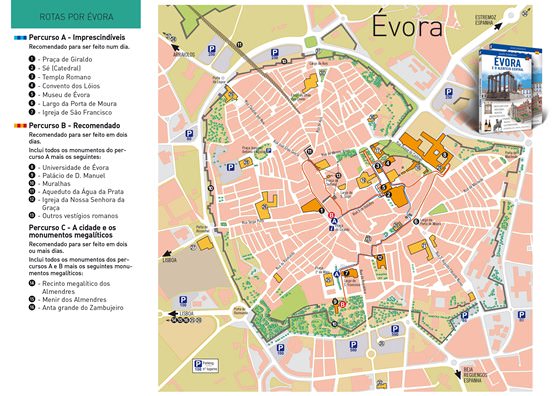
Large interactive map of Evora with sights/services search
City tours, excursions and tickets in evora and surroundings, moving around in portugal - transportation.

Economy roadmap of Portugal

Search for services, infrastructure and sights on map of Evora

Photogallery of Evora sightseeing
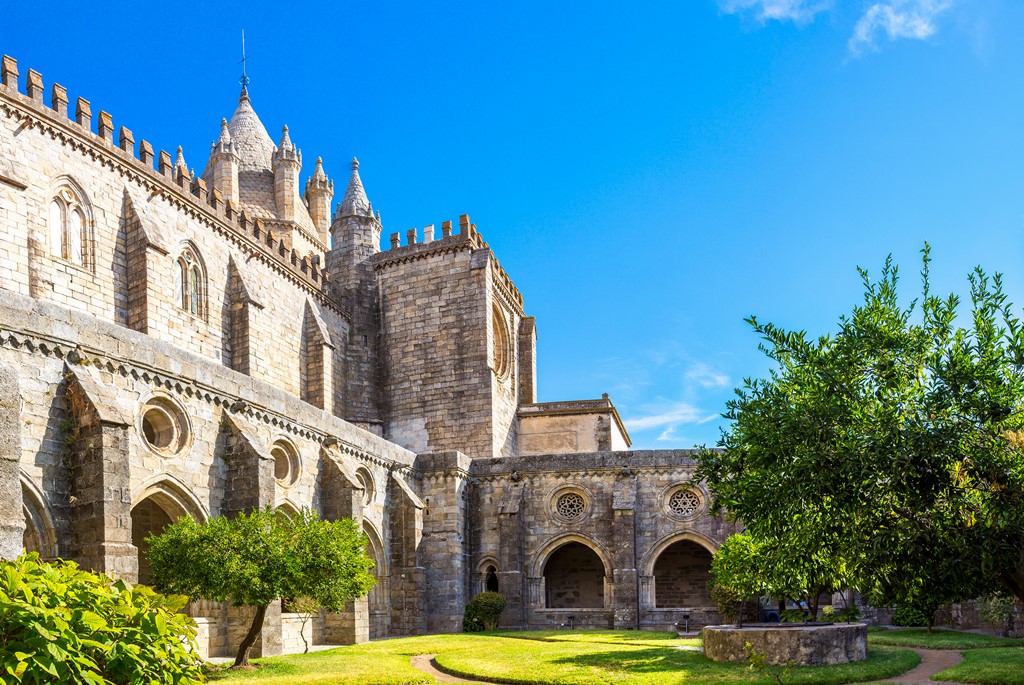
Our guide chapters over Evora
Evora sightseeing.
Detailed maps of neighbouring cities to Evora

- Search Please fill out this field.
- Manage Your Subscription
- Give a Gift Subscription
- Newsletters
- Sweepstakes
- Destinations
How to Plan the Perfect Trip to Évora, Portugal
This Portuguese city has incredible wineries, ancient Roman ruins, and a laid-back vibe.
Lindsay Cohn is a writer, editor, and avid traveler who has visited 45 countries across six continents — and counting. She contributes to Travel + Leisure, Hotels Above Par, InsideHook, Well+Good, The Zoe Report, and more.
:max_bytes(150000):strip_icc():format(webp)/Lindsay-Cohn-8b22fb2d452f46f5a256755f4d0f42a5.jpeg)
- Best Hotels and Resorts in Évora
- Best Things to Do in Évora
- Best Shopping in Évora
Best Restaurants in Évora
Best wineries in évora, how to get there.
Alena Zharava/Getty Images
Nestled in Portugal’s agrarian heartland of Alentejo, Évora charms travelers with its off-the-beaten-path appeal and historic heritage. In the center of it all sits the ancient Roman Temple of Évora, and down the road stands the huge Gothic Cathedral of Évora. Beyond the historic sites, the capital of Portugal's Alentejo region also boasts fantastic food and wine from nearby vineyards.
Vangelis Paterakis
I had the pleasure of visiting Évora on a tour with Jorge Martins , a fantastic Alentejo-based guide that I found through ToursbyLocals . Here's what you need to know to plan an overnight escape or even a day trip to Évora.
Related: 20 Best Places to Visit in Portugal
This Picturesque Portuguese City Has Incredible Wineries, Ancient Roman Ruins, and a Laid-back Vibe
Best hotels and resorts in évora , imani country house.
Among the most alluring agritourism options in the Alentejo region, Imani Country House charms travelers with its fireplace-clad suites, swimming pools, gardens, and farm-to-table fare. It’s a laid-back, rural retreat to commune with nature, sample hyperlocal ingredients — including olive oil made from century-old trees grown on the countryside estate — and simply relax.
Octant Évora
Situated just 20 minutes outside the city, Octant Évora feels like a contemporary oasis where guests can unwind and soak in the laid-back pleasures of Alentejo. Surrounded by olive trees, fruit orchards, and gardens that supply ingredients to the restaurant, it's pastoral with plenty of stylish, contemporary upgrades — from sleek rooms to a sunken alfresco terrace.
Convento do Espinheiro
Convento do Espinheiro is a 15th-century convent-turned-hotel on an eight-hectare plot of land that’s framed by olive and fig trees. With gardens, indoor and outdoor pools, a spa, and spacious rooms — plus Alentejo cuisine and wine tastings in the cellar where the monks used to conserve rainwater — the expansive property has all the makings of a perfect vacation.
Pousada Convento de Évora
Find another hotel housed in a former convent at Pousada Convento de Évora , which sits mere feet from the famous Roman Temple. When they're not marveling at the original cloisters in the inner courtyard, guests can take a refreshing dip in the outdoor swimming pool.

M'ar de Ar Aqueduto
Imagine waking up from a restful slumber and catching a glimpse of Aqueduto da Água de Prata. That’s one of the many perks of staying at M'ar De Ar Aqueduto . Housed in a 16th-century palace, the rooms are smart and well-appointed. There’s also an excellent spa, an outdoor pool, two bars, and three restaurants.
saiko3p/Getty Images
Best Things to Do in Évora
The roman temple of évora.
Constructed from granite and marble (which Martins told me had to be brought all the way from Estromez) and erected to honor Emperor Augustus, Templo Romano Évora dates back more than 2,000 years. (Talk about building things to last!) Over the centuries, it’s functioned as a temple, fortress, and even a slaughterhouse before receiving historic landmark status.
Chapel of Bones
Set inside Igreja e Mosteiro de São Francisco, the Chapel of Bones is one of the most intriguing attractions in Évora. I learned from Martins that the skeleton-encrusted chamber isn’t actually morbid at all. Franciscan monks opted to use the skulls and bones dug up from nearby graveyards to repurpose the land and “remind people of the transition between human life and what comes next in heaven.”
Cathedral of Évora
The largest medieval cathedral in Portugal, the dominating Cathedral of Évora is a massive fortified Gothic structure with massive towers, a central barrel-vault nave, gilded carvings, and grand organs that stands at the highest point in the city. To put the sheer scale of the project in perspective, construction started in 1186 and was only completed in 1250.
Aqueduto da Água de Prata
Designed by Francisco de Arruda and built from stone, Aqueduto da Água de Prata originally linked the city of Évora to the springs of Graça do Divor. This shining example of 16th-century engineering and innovation remains intact all these years later. If you’re interested in seeing this enduring landmark up close, there’s a walking and cycling path that follows it through cork oaks and farmlands.
Museum Frei Manuel do Cenáculo
While so much of the majesty of Évora comes from its history, it’s also a city that continues to thrive with each passing era. Museum Frei Manuel do Cenáculo displays a vast collection that covers everything from ancient Roman artifacts to fine paintings from the 1900s.
Related: This Charming Beach Town Is Called the 'Hamptons of Portugal' — and It's Home to a Massive Flock of Flamingos
Alex Robinson Photography/Getty Images
Best Shopping in Évora
There are many handicraft shops in Évora, but none quite like Oxalá . This compact space is impeccably arranged to show off an assortment of ceramics (I was tempted to grab a pitcher and set of cups), jewelry, chocolate, and wine.
O Cesto Artesanato
O Cesto Artesanato is a lovely store that sells both traditional and modern ceramics. Even if you aren’t in the market to buy a giant bowl or serving tray, smaller items like salt and pepper shakers make the perfect souvenir.
Galeri Gold
Martins recommends Galeri Gold on Praça 1 de Maio for Portuguese filigree jewelry and gemstone accessories. Travelers report that the wide assortment of goods and knowledgeable staff make it a must.
Mont'Sobro
Alentejo produces 95 percent of Portugal's cork. You can find all sorts of souvenir items — wallets, handbags, postcards, and shoes — made of cork at Mont'Sobro on the busy Rua 5 De Octobre.
Divinus Gourmet
Given the extraordinary array of products that come from the Alentejo region (and across Portugal), no shopping trip would be complete without stopping by Divinus Gourmet to stock up on olive oil, honey, jams, salt, spices, local wine, port from the Douro Valley, and ginjinha (a Portuguese liqueur made with sour cherries).
Courtesy of Dom Joaquim
Dom Joaquim
A favorite of travelers and native Eborenses, Dom Joaquim specializes in traditional regional cuisine. The space — like the food itself — is a taste of home (if your grandmother happens to be a fantastic chef from Alentejo). Patrons devour plates of black pork and leg of lamb in a dining room where stone walls are ornamented with iron sculptures and bottles of local wine.
Origens earns praise from diners and Michelin tasters for its contemporary Alentejo cooking and artful plating. The fact that it’s tucked away down a narrow street gives this place a sort of best-kept-secret feel.
Cavalariça Évora
If you’re searching for a spot to have lunch or dinner near the Roman Temple, look no further than Cavalariça Évora . Tucked inside the Palácio de Cadaval, it’s an atmospheric gem of a restaurant with a plant-studded terrace that’s ideal for savoring Alentejo specialties such as sourdough bread with house-made butter, cured pork, and sheep’s milk cheese.
Enoteca Cartuxa
“I suggest Enoteca Cartuxa, a restaurant and gourmet shop right beside the Roman Temple,” says Martins. Dishes like pork cheeks and octopus are full of flavor. You’ll also find a superb selection of wines (many from Cartuxa Winery) available for purchase.
Fábrica dos Gelados
Fábrica dos Gelados is something of an institution in Évora. People line up for scoops of creamy gelato made fresh daily. As someone who can’t eat dairy, I was pleasantly surprised to see the abundance of lactose-free fruit flavors, ranging from passionfruit and strawberry to melon and banana chocolate.
inaquim/Getty Images
Located about 30 minutes from Évora, family-run Ervideira is known in the area for its superb vintages. Visitors can do tours and wine tastings paired with regional products like meat, cheeses, bread, and olive oil. There’s also a bottle shop in the heart of the city if you’re short on time and can’t make it to the estate.
The passion project of award-winning Portuguese oenologist Antonio Macanita, FitaPreta embraces much of what makes the winemaking culture of Alentejo so special. The winery is housed inside a 14th-century medieval palace that's brimming with history, and the wine reflects the unique terroir of the region. In addition to tours of the cellar and tastings, picnics and gastronomic experiences are available.
Oxalá (not to be confused with the store of the same name) is a bespoke operation helmed by owner and winemaker Hugo Campos that I learned about from Dale Ott, the owner of Nossa Imports. The estate comprises 15 hectares and grows a handful of different grape varietals. So if you’re interested in learning about — and sipping — wine from Alentejo, it’s a wonderful place to visit.
Évora is located about 90 minutes away from Lisbon . It’s easy to rent a car and drive or arrange transport. There’s also direct bus and train service between the two cities.
Related Articles

15 Top Attractions & Things to Do in Évora
Written by Paul Bernhardt , Lana Law and Michael Law Updated Dec 27, 2023
Nestling in the heart of Portugal's sun-baked Alentejo province, Évora is one of the country's oldest and most enchanting cities . Rising to prominence under the Romans, the town was also occupied for some 500 years by the Moors. Medieval Évora thrived as a center of learning and the arts, and was patronized by a succession of Portuguese kings. Some of the key attractions are the churches and monasteries that stand as testament to a devout and pious legacy.
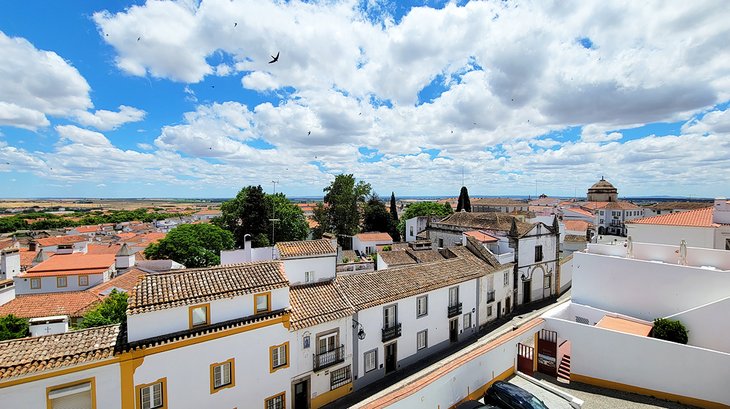
The melding of such diverse cultures and religions coupled with an abundance of different architectural styles prompted UNESCO to declare Évora's old town a World Heritage Site .
Conveniently, this precious hoard of monuments and museums is clustered together within the city walls, and many of the most important things to see and do in Évora can be easily explored on foot .
Similarly, Évora's lively market town atmosphere is best appreciated by following the narrow cobblestone lanes that snake away from the brooding cathedral to pass gurgling fountains and flower-flecked squares. Along the way, colorful handicraft stores and family-run cafés busy themselves under granite-wrapped arcades. Restaurants, meanwhile, serve some of the tastiest gastronomy in the land.
For ideas on the best places to visit, see our list of the top attractions in Evora.
Sé (Cathedral)
Igreja de são francisco (bone chapel), roman temple, museu de évora (évora museum), termas romanas, palácio dos duques de cadaval, igreja são joão evangelista, praça do giraldo, universidade de évora, largo da porta de moura, aqueduto da água de prata (aquaduct), pousada convento de évora, jardim público (public gardens), megaliths tour, arraiolos-estremoz circuit, frequently asked questions, how do you get from lisbon to évora, how do you get to évora from porto, what are some of the must-visit castles near évora, what are some must-visit destinations near évora, map of attractions & things to do in évora, evora, portugal - climate chart.
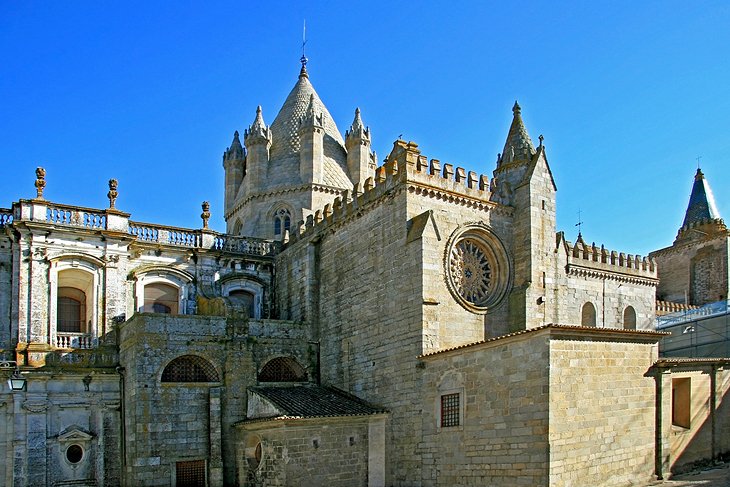
Don't be put off by Évora cathedral's rather austere complexion. Its weathered granite façade has after all endured the elements since 1204, and the heavy-set structure can't help but resemble a fortress, a look accentuated by a pair of imposing asymmetrical bell towers.
Those with an eye for architecture will notice the melding of the Romanesque with the Gothic, but everyone will gush at the stunning 14th-century sculpted Apostles that wrap themselves around the building's main portal.
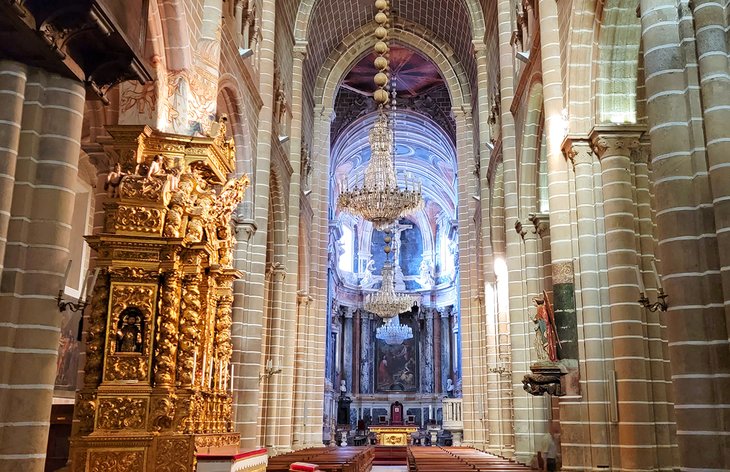
Inside, even whispering sounds too loud, but the mood of secluded gravity is lifted somewhat by the 18th-century high altar and polished marble chancel.
The Museum of Religious Art , housed in the adjoining Baroque-style building formerly used to house the choir boys, is brimming with rare and priceless artifacts fashioned out of gold, silver, and other precious metals.
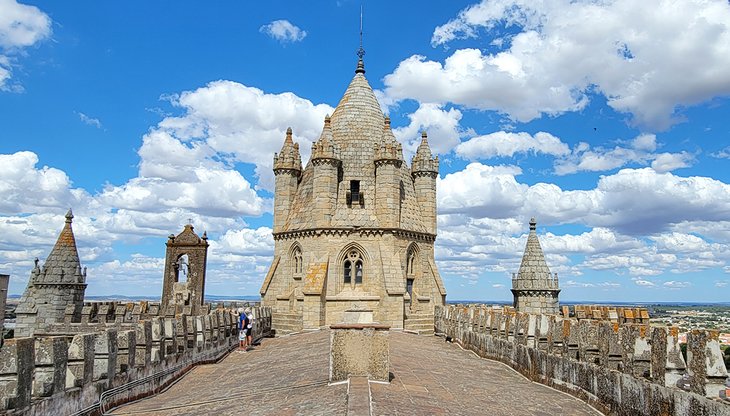
The top draw, though, is climbing the winding stairs to the roof from where a memorable view of the Alentejo can be admired.
Ticket options include access to just the cathedral and cloister, or this can be combined to include the roof (tower), and also the museum.
Location: Largo do Marquês de Marialva, Évora
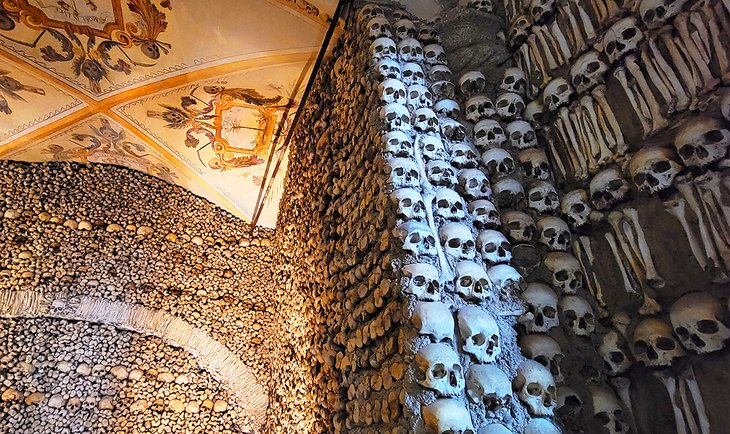
The rather nondescript church of Saint Francis just happens to feature the most macabre tourist attraction in Portugal, the grisly Capela dos Ossos (Chapel of Bones). Visitors of a sensitive disposition beware: the Bone Chapel is lined with the remains of 5,000 monks , disinterred from local cemeteries ostensibly to make room for lesser mortals.
Hundreds of skulls and broken skeletons wallpaper the 16th-century oratory. Bizarrely, two wizened corpses, one a child, dangle intact from a chain near the altar. Look up to see equally grisly images painted on the ceiling.
Despite its creepy reputation, the chapel draws tourists of all ages fascinated by its gruesome interior design. And no one appears fazed by the sarcastic reminder across the entrance that reads: Nós ossos que aqui estamos, pelos vossos esperamos (We bones that are here await yours).
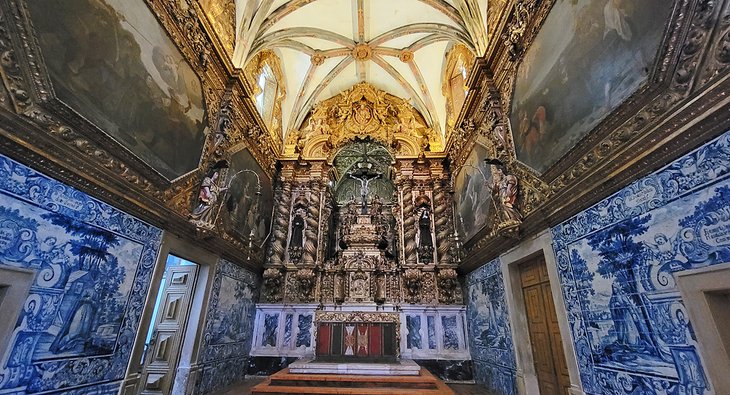
Tourists often wander into Igreja de São Francisco, the main church, expecting to find the bones. The chapel of bones is immediately next door to the church and entered through its own doorway, and there is an admission fee. The church itself, which is free to enter, has a fabulously ornate interior and is well worth stepping inside to see.
Address: Praca 1° de Maio, Évora
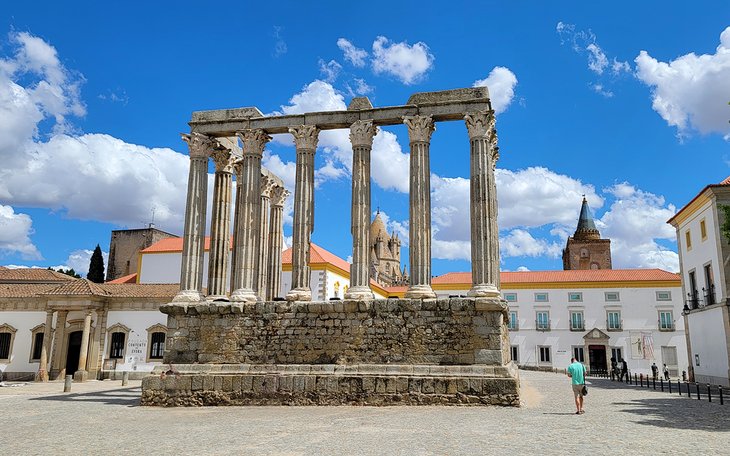
The city's pin-up tourist attraction is still often referred to as the Temple to Diana, despite the fact that there's no proof the monument was ever dedicated to the Roman goddess. The legend persists, however, as does the misnomer. But it doesn't really matter; this remains Évora's head-turning crowd pleaser, and one of Portugal's most significant Roman landmarks.
Believed to have been erected in the 2nd or 3rd century AD, the 14 surviving columns topped by Corinthian capitals stand solid over a granite base; the architrave, itself an impressive piece of masonry. The ancient structure has worn well, and you can't help feeling a sense of awe as you pause under its mighty façade.
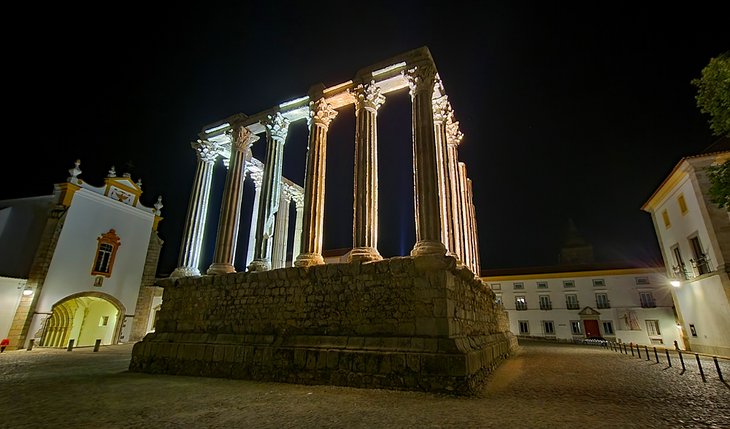
At night, after the crowds have faded away, the temple is illuminated and the soft, ethereal glow only adds to its grandeur and mystique.
Location: Largo do Conde de Vila Flor, Évora
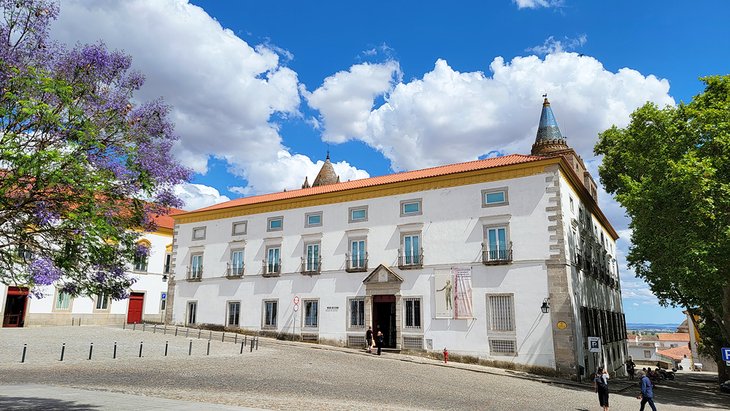
Modern and kid-friendly, Évora Museum does away with the stuffy and cramped. Instead, this delightfully engaging cultural and educative draw is spacious, light, and airy, and superbly designed to showcase a collection of regional treasures housed in what was once the residence of bishops and noblemen.
Yes, this is a former palace building dating way back to the 16th century, and the city's history is all here under one roof. It's worth spending time mulling over the exhibits. For instance, the art gallery features an extraordinary 16th-century Flemish polyptych, a fantastically detailed painting of 13 panels executed in vivid Technicolor, and this kind of brushwork requires serious study.
The main core of the museum is its collection of archaeology, and its Roman sculpture pinches all the glory - a giant 2nd century AD column rises up like a rocket as if to emphasize the period.
Across the square from the musuem is the Centro de Arte E Cultura , housed in the Forum Eugenio de Almeida building . This wonderfully restored old structure, which at one time was the Inquisition Palace, hosts an ever-changing series of artwork installations by national and international artists. It's free to enter and a nice cool escape from the summer heat (you can find washrooms here, too).
Location: Largo Conde Vila Flor, Évora
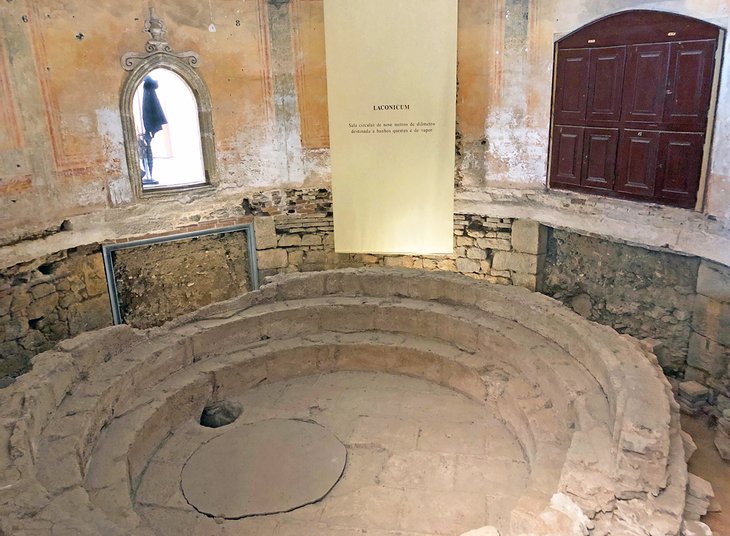
Another significant Roman-era attraction, the Roman Baths were discovered in 1987 beneath the town hall, the Câmara Municipal. Dating back to the first century AD, the remains include an arched brick doorway - the entrance to an amazing sunken room replete with a well-preserved circular steam bath, or laconicum , nine meters in diameter. Vestiges of the furnace or praefurnium (essentially, a central heating system) and the natatio (open-air swimming pool) can also be admired.
This extraordinary example of ancient architecture would have been housed in the largest public building in Roman Évora and today can be visited for free, Monday through Friday during office hours.
Address: Câmara Municipal, Praça do Sertório, Évora
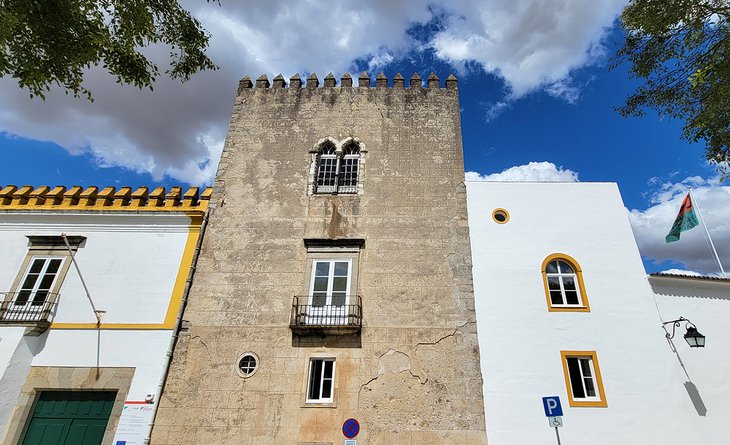
The grand-sounding 14th-century Palace of the Dukes of Cadaval incorporates vestiges of the city's long lost castle, the castellated walls surrounding the property being an obvious reference.
The palace is still a private residence, but the owners have selected a number of rooms in which to showcase valuable family heirlooms, a fascinating collection that includes valuable 15th-century illuminated manuscripts, clunky 16th-century suits of armor, and assorted antique weaponry, as well as painting and sculpture from the 17th and 18th centuries.
There's a spooky surprise in the shape of the palace's pentagonal Torre das Cinco Quinas - the Tower of the Five Shields. Said to be haunted, this is medieval ghost busting at its best. The café in the gardens offers a relaxing interlude from chasing phantoms.
Address: Rua Augusto Filipe Simões, Évora
Official site: www.palaciocadaval.com
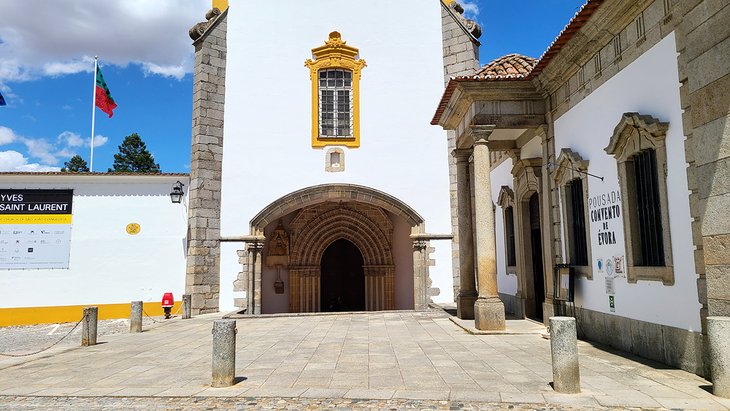
The unassuming box-like exterior of the church of St. John the Evangelist belies its eye-popping interior, a floor-to-ceiling starburst of fabulous early 18th-century azulejo (tile) panels, which depict scenes from the life of São Lourenço. Even non-religious types will take a step back to admire this outstanding effort by painter António de Oliveira.
The 15th-century church, however, hosts a grisly sideshow, an ossuary full of bones from tombs in the vicinity. While tiptoeing towards the nave, look out for the building's oddity - the Moorish cistern hidden under a trapdoor set among the pews. If it's locked, ask the custodian to lift the lid on this intriguing anomaly.
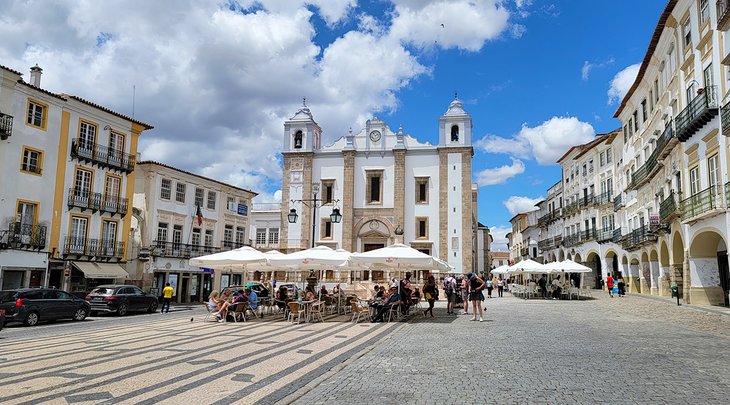
Évora's handsome central square is the city's bustling hub, a favorite meeting place where locals mingle with tourists. Probably named after Geraldo Sem-Pavor (the Fearless), the outlaw who ousted the Moors in 1165, the square hosts a lively weekend market, but is a shopping destination in its own right, with several boutiques situated under the graceful arcades that line Giraldo's eastern flank; nearby Rua 5 de Outubro is lined with shops that sell handicrafts and curios, from copperware to carved cork.
In summer, restaurants set tables across the esplanade, and the colorful scene is café society at its most ebullient. It's a far cry from the beheadings and Inquisition burnings witnessed in darker, medieval times. Fortunately, today's entertainment is likely to be animated street theater or a live music concert staged under the shadow of the 16th-century Igreja de Santo Antão.
Location: Praça do Giraldo, Évora
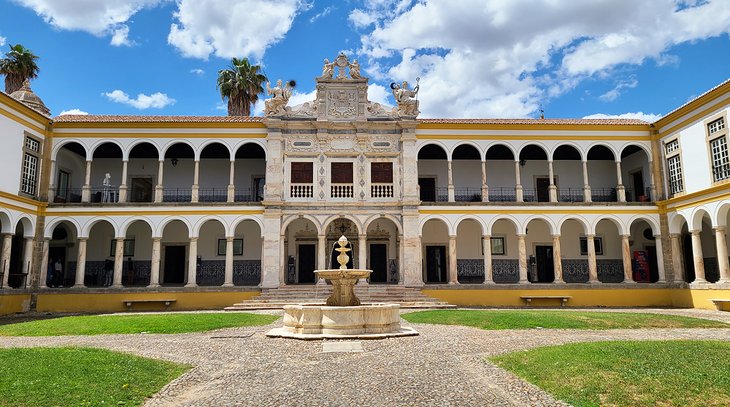
Évora's old university halls are awarded full marks for looks. Its graceful Renaissance cloister is dripping with sculpted marble and embellished by sky blue azulejos (tiles). But the real learning experience begins in the classrooms, the walls of which have been decorated with tiled panels representing each of the subjects taught.
Évora university was founded in 1559, the hallowed ambiance enlivened by the use of tiles to depict studious themes such as Aristotle teaching Alexander, and Plato lecturing to disciples. Some of the panels are enormous - complete works of art that still gleam 200 years after being painted.
The school is still used by students, and visitors must check with the gatekeeper and pay a fee before exploring. The 18th-century Baroque chapel, known as the Sala dos Actos , is certainly worth investigating. If it's closed, ask the custodian for the key.
Location: Largo dos Colegiais 2, Évora
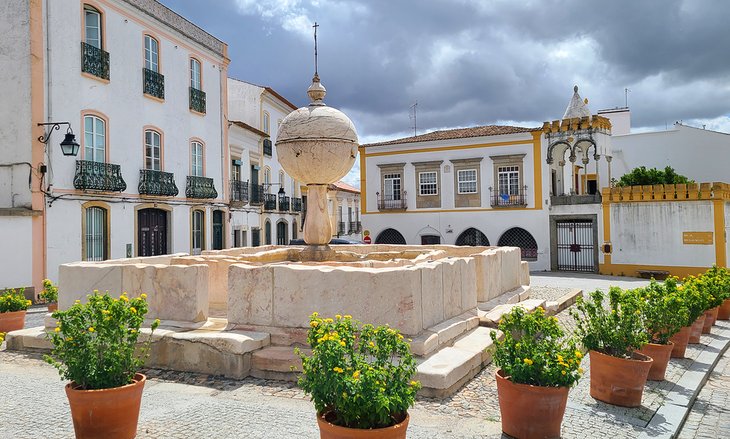
The Moors' occupation of Évora left its cultural footprint throughout the city, and this picturesque square is so named because of the Moorish gateway that used to guard its western approaches.
Today, only vestiges remain, but sightseers can admire the square's other architectural draw, the Renaissance fountain with its iconic marble sphere. It dates from 1556 and is still in remarkable condition considering that the fountain's base effectively acts as a traffic island in the middle of the road. Fortunately, the street is not too busy, and the little cafés lining either side provide for an impromptu coffee break. Otherwise, come back at night to see the orb shimmer under spotlight.
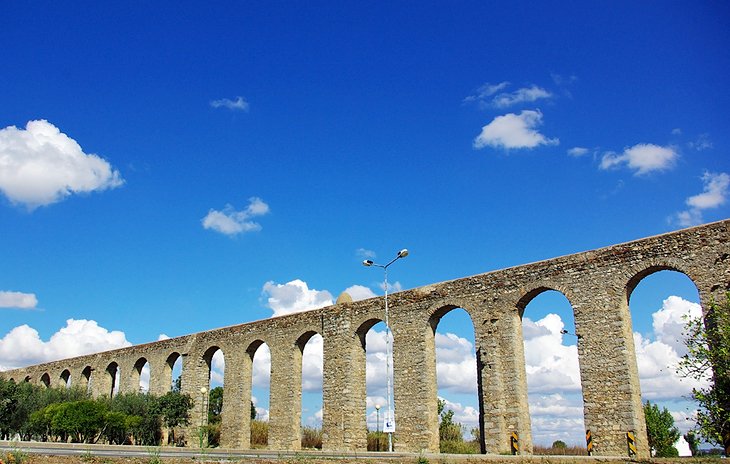
The whimsically named Aqueduct of Silver Water caught the imagination of Portugal's greatest poet, Luís de Camões, who described the majestic 16th-century watercourse in his epic Os Lusìadas , published in 1572. The structure is still regarded with awe, the tallest arches of the surviving nine-kilometer stretch reaching a height of 26 meters and visible throughout the city and beyond.
Over the years, shops, warehouses, and other commercial premises have been constructed within its arches. There are even some houses snuggled between its walls. The most interesting examples can be admired in and around Rua do Cano .
For some truly imposing views of the aqueduct, visitors should follow the well-signposted trail that begins just outside the city walls.
Location: Rua do Cano, near Largo do Chão das Covas
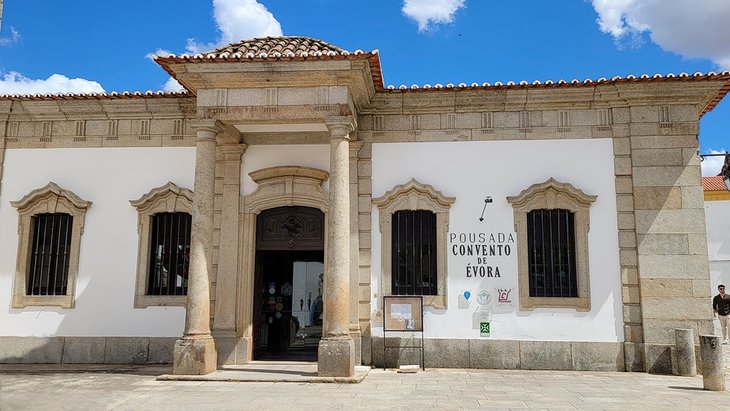
Spending a night in the cells takes on new meaning in this 15th-century former monastery (Convento dos Lóios). The building, is now the luxurious pousada , Pousada Convento de Evora , a hotel of exceptional historical character.
Non-residents are welcome to step under the Manueline porch to take a peek inside. Actually, the portal dates from 1485 and is a surviving feature of the original convent, which was largely destroyed by an earthquake in 1755. Visitors are limited in where they can wander. If you want to look around, it's best to book a room.
Location: Largo do Conde de Vila Flor
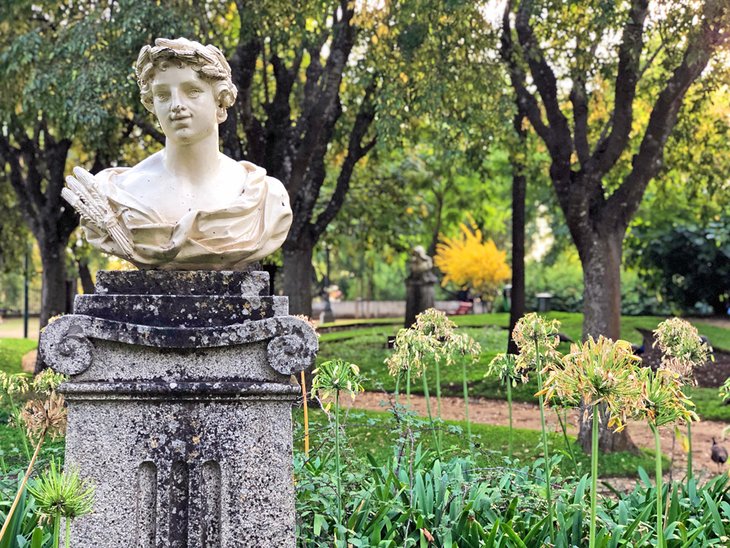
Prime picnic territory and perfect for a pleasant stroll, the city's public gardens embroider the southern edge of the old town, near Igreja de São Francisco . The grounds are set inside the walls of the once opulent Palácio de Dom Manuel, the only remains of which is the elegant Galeria das Damas , a pavilion built for Manuel I in the 15th century.
Early spring sees the gardens burst into color when flowers carpet the lawns, and park benches are at a premium. Weekends attract local families, and you might have to wait for a table at the outdoor café spread over a light-dappled terrace.
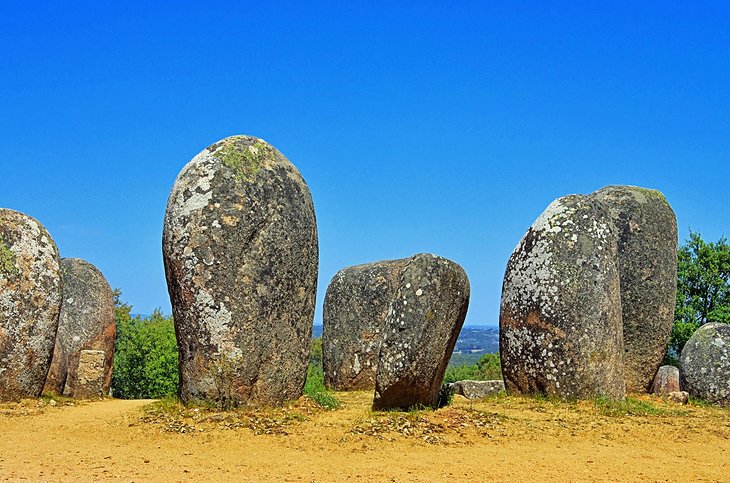
About 15 kilometers west of Évora is the isolated megalithic Cromeleque dos Almendres (Cromlech of Almendres), a mysterious oval made up of 95 lichen-encrusted granite stones that date back to between 4000 and 2000 BC. This mysterious piece of Neolithic real estate is believed to have been a temple dedicated to a solar cult. Indeed, some archaeologists maintain that the circle functioned as some kind of primitive astronomical observatory.
As if to strengthen the enigma surrounding their purpose, a solitary two-and-a-half-meter-high stone, known as the Menhir of Almendres, is positioned one and a half kilometers away from the cromlech. The two sites are linked by a marked pedestrian trail that snakes through an olive grove, and guided tours led by local archaeologists are available to those with an interest in prehistory.
Indeed, while kids will appreciate the hide-and-seek opportunities provided by the stones, mature minds will no doubt be moved by this ancient and sacred destination.
Location: Guadalupe, between Évora and Montemor-o-Novo
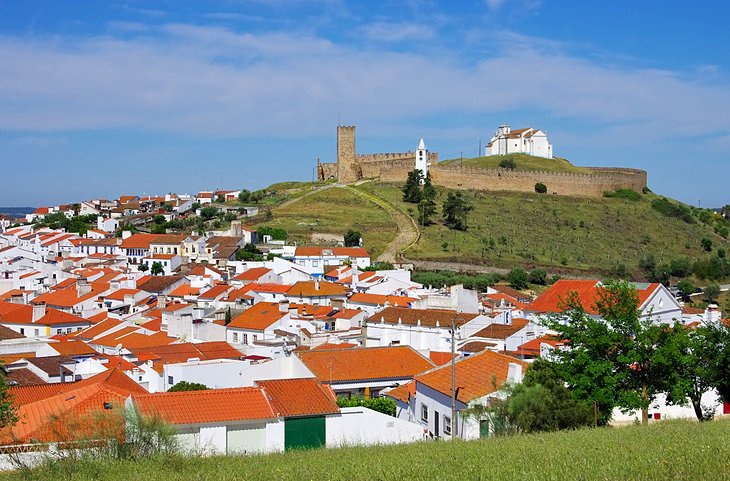
Arraiolos, 23 kilometers northwest of Évora, is your first stop on this scenic circular tour. The fortified village is noted for the dramatic ruins of its 14th-century castle , the walls of which embrace the whitewashed Igreja do Salvador .
The hilltop stronghold affords impressive views of the surrounding countryside, but what really crowns this picturesque hamlet is its reputation for needlecraft. Some of the best carpets in Portugal are woven here, hand-embroidered, bright wool rugs stitched by nimble-fingered ladies following a tradition that has endured since the 13th century. The finest examples are the elaborate floral designs crafted over several months by teams of women who weave around the clock to produce beautiful and intricately designed tapestry.
The rugs make unique souvenirs, either as wall hangings or floor coverings, and are sold in the carpet shops found threaded along the main street.
After lunch, head east to Estremoz, famous for its beautiful marble. So plentiful is this precious stone, it adorns much of the town and is even used in the cobblestones and steps. A castle dating from 1258 presides over the old town and is now an elegant pousada (historic hotel). During the early 14th century, it was the residence of King Dinis and Queen Isabel. Today, visitors can admire a marble statue of the queen on the terrace or climb the 13th-century keep for panoramic views.
Nearby is the Municipal Museum with a collection of antique furniture, local pottery, and ecclesiastical art. For shoppers, the Saturday market in Rossio Marquês de Pombal, the town's main square, sells a fabulous selection of local cheeses and pottery and is one of the biggest markets in Portugal.
It's a relatively straightforward undertaking to drive the 140 kilometers east out of Lisbon along the tolled A6 motorway to Évora. You can use either the 25 de Abril or Vasco da Gama bridges to join the A6, and the journey takes approximately 1.5 hours. Note that the highways have tolls; ensure your rental car has a transponder, or have money available to pay at the toll booths.
Évora is well connected by public transport to Lisbon. Rede Expressos buses operate out of Lisbon's central Sete Rios bus station on a daily basis.
CP trains connect Lisbon with Évora four times daily out of the capital's Oriente, Sete Rios, and Entrecampos railway stations. Note that Évora railway station is located one kilometer south of the city center, a 20-minute walk.
It's a long drive from Porto to Évora. The quickest route is via the A1 and A6 motorways, a journey of 410 kilometers that, traffic permitting, takes around four hours. For those traveling by train or bus, a change at Lisbon is required.
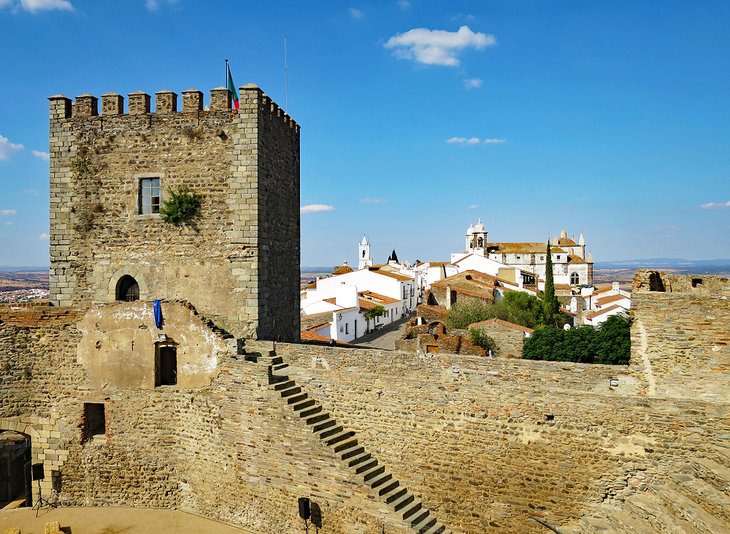
Évora's circuit of medieval walls is all that remains of the city's historic defenses. But the Alentejo is a region renowned for its collection of splendid castles , and you don't have to travel too far to admire them.
Monsaraz : The diminutive medieval walled town of Monsaraz, 53 kilometers southeast of Évora near the frontier with Spain, boasts one of the finest examples of a hilltop castle anywhere in Portugal. Built in the 14 th century as part of the country's border defenses, the structure features a sturdy keep that commands a truly impressive 360-degree panorama of the surrounding countryside.
Évoramonte : Located 29 kilometers northeast of Évora, off the N18 highway towards Estremoz, is Évoramonte castle. This eye-catching, early 14 th -century stronghold is noted for a peculiar architectural feature: its walls are bound by bold stone "ropes" - a stonemason's imaginative way of securing the building after the previous castle fell in an earthquake in 1513.
A Renaissance-style keep was added in the 16 th century as if to provide a watchful eye over neighbor Spain, but only the walls and gate towers are accessible to the public.
Vila Viçosa : A 45-minute drive northeast brings you to the palatial town of Vila Viçosa. The destination is recognized for its Paço Ducal, or grand royal palace - the last residence of the Portuguese monarchy and a must-visit point of interest.
Allow yourself a leisurely hour or so to absorb the building's richly decorated interior. The Sala dos Duques is especially opulent, lined as it is with tapestries depicting the life of Achilles.
The castle was the original home of the Dukes of Bragança before the palace was built. The interior can be explored, after which you can climb the outer walls for pleasant town views.
Viana do Alentejo : Ideally, the drive to this pleasant southern Alentejan town, 48 kilometers southwest of Évora, should be made in spring, when the countryside is flecked with color and the air heavy with a fragrant scent.
The destination features two cultural highlights: a highly decorative castle and a vast pilgrim church. The castle features a sequence of elaborate battlements, the unusual cylindrical towers reflecting a Moorish influence.
The enormous Nossa Senhora de Aires is a scene of joviality every April, when hundreds of people congregate here to take part in the vibrant Romaria a Cavalo horse pilgrimage festivities.
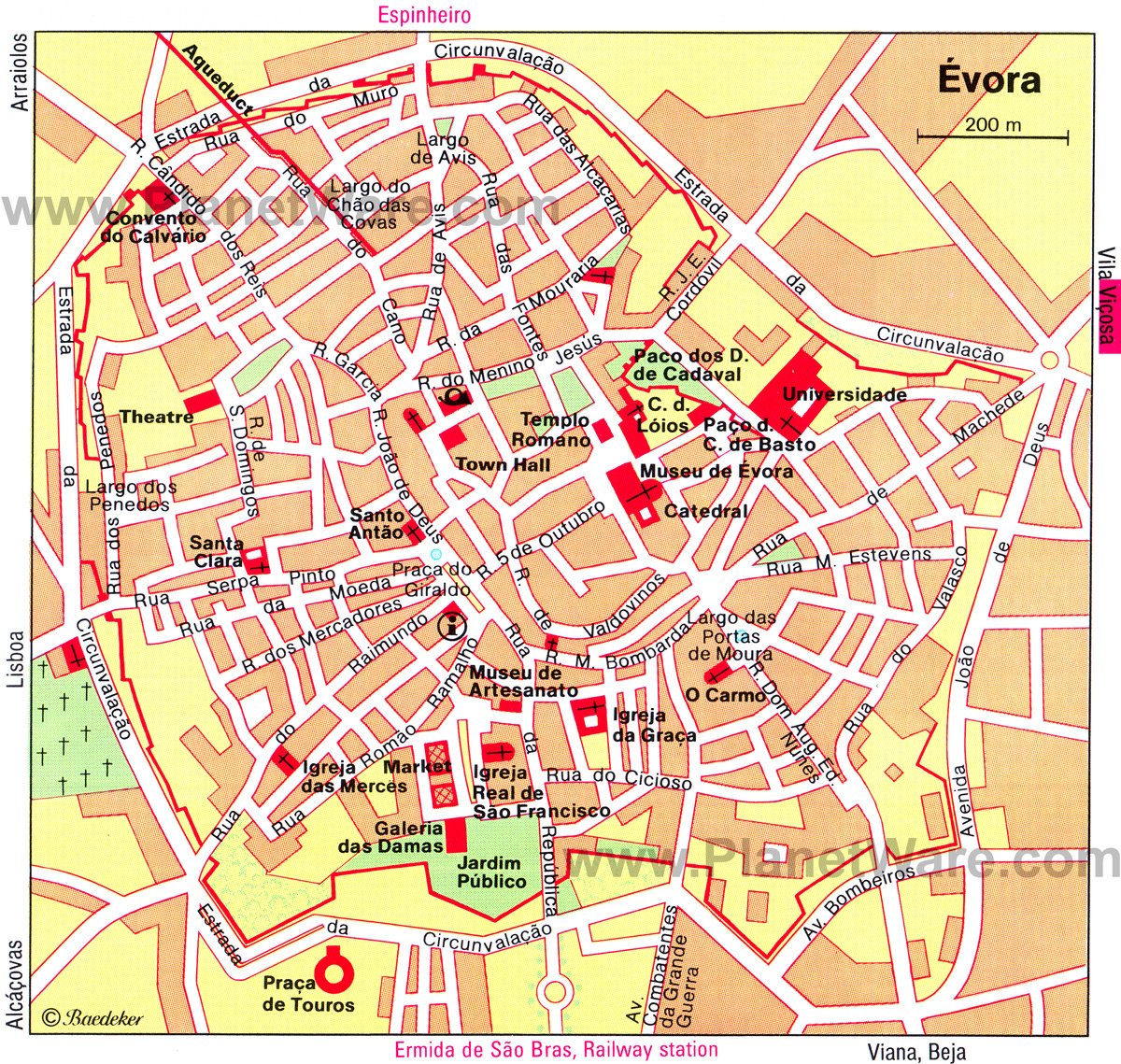
More on Portugal
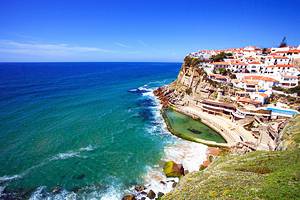
7 Unique Things to Do in Évora
The ancient walled city of Évora attracts large numbers of day-trippers thanks to its eye-catching architecture and historic centre packed with landmarks dating back centuries.

The ancient Roman Temple of Diana (Photo: Guillén Pérez via Flickr / CC BY-ND 2.0 DEED)
The capital of Portugal’s south-central Alentejo region, the city’s distinctive white housesand argyle roofs account for much of its charm. But it is Évora’s roots dating back to Roman times that have helped elevate it into a major tourist destination, with the city boasting a remarkable collection of well-preserved monuments, making it something akin to a living museum. Less than 1.5 hours by road from Lisbon, it’s also a popular excursion for visitors based in the Portuguese capital. Here are 7 of the most unique things to see and do in Évora.
Explore the remains of a Roman temple
One of Europe’s best-preserved Roman monuments, the Évora Roman Temple (commonly, but many believe inaccurately, known as the Temple of Diana) was awarded World Heritage status by UNESCO in 1986 – and for good reason. Even bereft of its original roof, mosaic-covered floor, reflecting pool and 4 of its 18 Corinthian columns, the site’s substantial intact features help draws large crowds of daily visitors who come to soak up the dripping-with-history aura. Little wonder that the attraction adorns postcards and tourism posters, as well as providing the back-drop for many a photo opportunity for the droves of sight-seers who flock here. Largo do Conde de Vila Flor / Open all hours
You can visit the temple and the rest of Évora’s Old Town as part of an organised walking tour with a local guide. Find available tours at GetYourGuide .
Visit a bone-chilling chapel
Not for the faint-hearted, the Chapel of Bones is best known for the some 5000 human skulls that embellish its arcades, columns and walls. Built in the 17 th century, the chapel is part of the St Francis Church and was created on the initiative of three Franciscan friars for the purpose of conveying the message of temporariness and the fragility of human life. The skulls and bones that decorate the site all came from graves in the convent church and from other churches and cemeteries across Évora, providing visitors to the city with an unnerving but endlessly fascinating tourist attraction.
Praça 1º de Maio 4 / Mon-Sun 9am-6.30pm

Inside the Chapel of Bones (Photo: kenward via Flickr / CC BY 2.0 DEED)
Marvel at an imposing 12th-century cathedral
The approach to Évora Cathedral can be a daunting experience, with its fortress-like appearance evoking images of feudal soldiers aiming their cannons at you from up high. But fear not, Portugal’s largest medieval cathedral serves an entirely benign purpose nowadays, with its for the many who come to witness it. While impressive from the outside, it’s worth venturing into its confines too, where you’ll find one of Europe’s oldest Renaissance organs , a small museum of sacred art, and a terrace reached via one of the bell towers and affording sublime views across the city.
Largo do Marquês de Marialva / Mon-Sun 9am-5pm

Statues on the exterior walls of Évora Cathedral (Photo: Phillip Capper via Flickr / CC BY 2.0 DEED)
Check out a grand palace
Another of Évora’s seemingly never-ending assortment of landmarks dripping with history and grandeur, Palácio Duques de Cadaval is a magnificent building with a colourful and varied back-story. Since being built on the ruins of an Moorish castle in the late 15 th century, the palace has served as a royal residence, a burial place and even a prison. Today several of its rooms are open to the public and the venue also plays host to frequent art exhibitions and other cultural events. Spare time to visit the Igreja dos Lóios next door, a majestic church with stunning tiles lining the walls and an ornate golden altar.
Weds-Sun 10am-6pm Closed Mon-Tues
Learn about the city’s rich heritage at a museum
As mentioned, the entirety of Évora has the look and feel of a veritable museum, but the city also has its own self-contained cultural institution. Officially named Frei Manuel do Cenáculo National Museum, Évora Museum houses a huge collection of Roman sculptures, Visigothic and medieval artifacts, and Portuguese and Flemish paintings that chronicle the city’s rich heritage. While exploring the museum, visitors can discover its riveting stories courtesy of an audio tour, downloadable to your phone.
Largo do Conde de Vila Flor / Tues-Sun 9.30am-5.30pm Closed Mon

Exhibits on display at Évora Museum (Photo: Stephen Colebourne via Flickr / CC BY 2.0 DEED)
Get a taste of the local wine scene
The Alentejo region is widely considered one of the finest anywhere in the world for wine production – and at its heart is Évora. There are a wide number of renowned vineyards and wineries dotted around the city’s rural parts, where visitors can join guided tours and learn about the history of wine-making , from the earliest methods to current day techniques. Many of them also house tasting rooms where you can sample some of the home produce and purchase bottles to take away with you.
Latest Articles
- Where to Buy Benfica Football Tickets September 13, 2024
- Where to Buy Vintage Van Cleef Bracelets & Necklaces September 13, 2024
- The 5 Most Unique Beaches in Ibiza September 13, 2024
- Editor Picks: Hotels in Barcelona with a Pool September 13, 2024
- Nobel Prize Museum, Stockholm: A Comparison of Tickets & Tours September 12, 2024
Home > What to See and Do
Évora Sightseeing Guide
Itinerary advice.
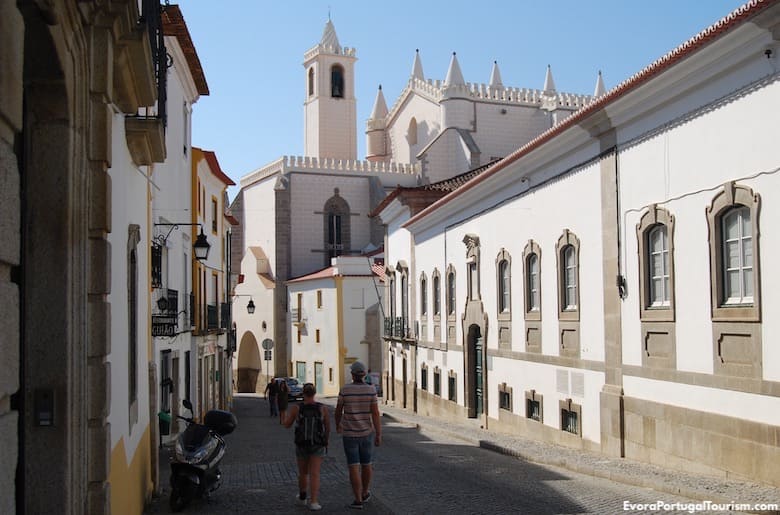
Walking around the World Heritage center of Évora, you find monuments from different periods in history, but mostly from the 15th century.
É vora has a variety of monuments, almost all of them inside the city’s wall. The wall dates back to Roman times and was rebuilt by the Visigoths and the Moors, and again in the 1300s. It has a perimeter of 3km (close to 2 miles), and had ten gateways, but one of them closed and new towers were added in the 17th century. One of these towers is the entrance to the old city when you walk from the bus station.
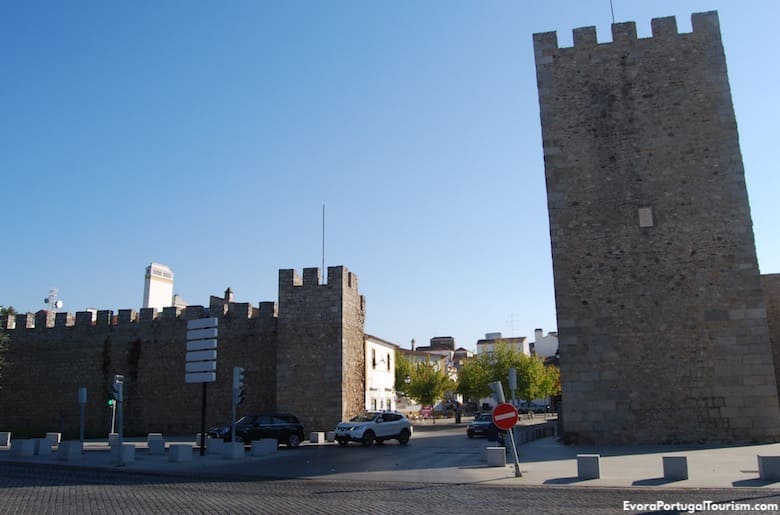
The towers and entrance to the walled city of Évora, down the road from the bus station.
The oldest attractions are from Roman Évora (a temple and baths ), but this is essentially a well-preserved 15th-century city. It’s filled with interesting architectural details, best enjoyed on a walk around the cobbled lanes of the World Heritage center, which is a charming open-air museum.
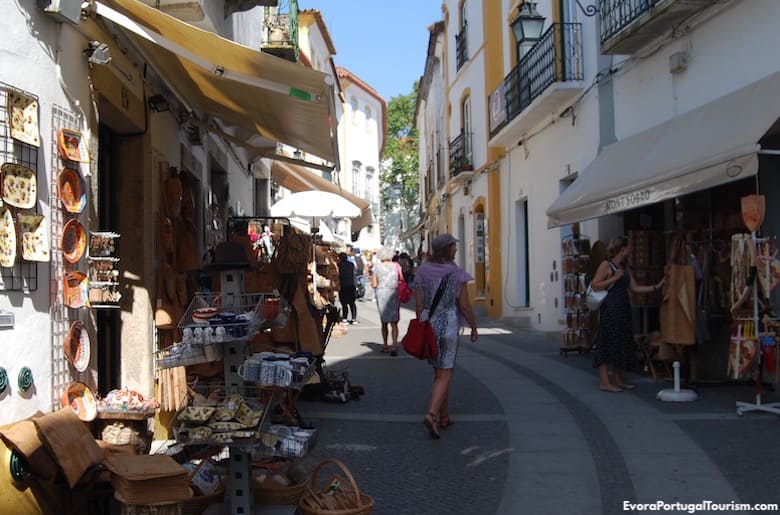
Rua 5 de Outubro is one of Évora's main pedestrian streets
The main streets are Rua 5 de Outubro (which goes from the main square to the cathedral and the Roman temple) and Rua João de Deus (the pedestrianized shopping street, behind the main square). That main square is Praça de Giraldo , home to the tourist office and one of the city’s main churches, Igreja de Santo Antão .
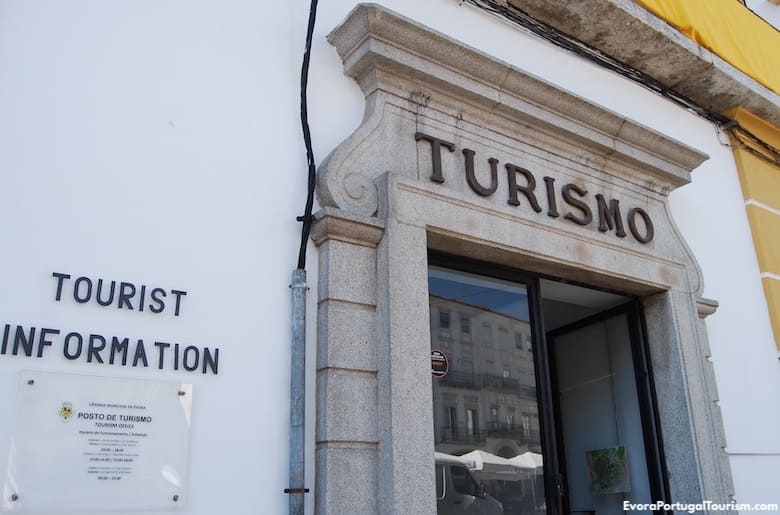
The tourist office in the main square, Praça de Giraldo.
The winding streets also lead to one of Portugal’s oldest universities ( Évora University ) and to the city’s most memorable sight, the Chapel of Bones , that’s part of a royal church, considered one of the finest examples of Gothic and Manueline (Portuguese Gothic) architecture.
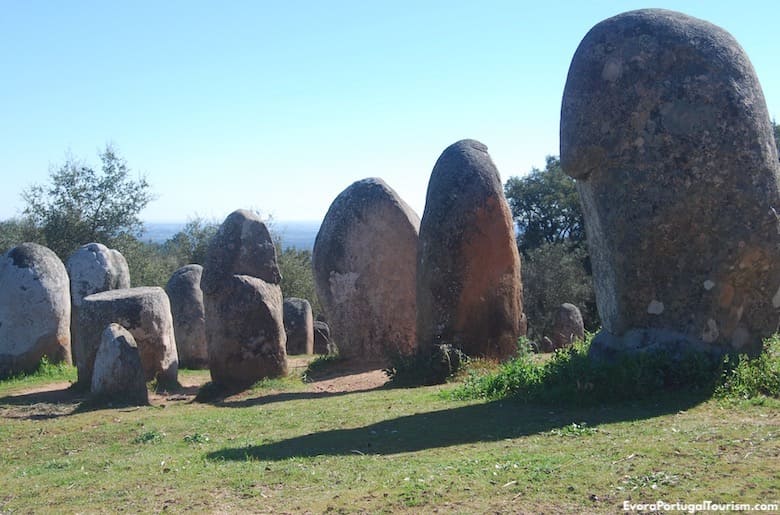
The stone circle of Almendres is one of a number of prehistoric monuments around Évora
Around the city is an extraordinary concentration of prehistoric monuments -- dolmens (megalithic tombs with a large flat stone laid on upright ones), menhirs (tall upright stones) and cromlechs (stone circles). Dolmens are mostly found in Britain, France, and Portugal, and the one in Zambujeiro is the largest of them all. If you visit just one prehistoric monument, however, make it the Cromlech of Almendres , the stone circle that’s often called the “Portuguese Stonehenge.” For the megalithic sites outside the city you’ll need a car, but you can walk everywhere in the center.
Complete Évora Guide
Sightseeing.
Top 10 Attractions
Day Trip from Lisbon
Roman Temple
Giraldo Square
Porta de Moura Square
Chapel of Bones
Évora Cathedral
Loios Church
Misericórdia Church
Santo Antão Church
São Tiago Church
Graça Church
Santa Clara Church
Ermida de São Brás
Évora University
Roman Baths
Évora Museum
Dom Manuel Palace
Carriages Museum
MADe Museum
Casas Pintadas
Megalithic Sites
Almendres Chromlech
Dolmen of Zambujeiro
Where to Stay
Top 10 Hotels
How to Get There
Transportation
Portugal Travel Guides
Lisbon Beaches
- Miranda do Douro
- Viana do Castelo
- Corvo, The Crow Island of the Azores
- Faial, The Blue Island of Azores
- Flores, The Yellow Island of Azores
- Graciosa, The White Island of the Azores
- Pico, The Black Island of Azores
- Santa Maria, The Sunshine Island of the Azores
- São Jorge, The Brown Island of Azores
- São Miguel, The Green Island of Azores
- Terceira Island, The Festive Island of Azores
- Central Portugal
- Lisbon and Tagus Valley
- Porto & Northern Portugal
- Portugal Survival Guide
- Entering Portugal
- Guide to Learning Portuguese
- Portugal Holidays
- Average Temperatures in Portugal
- Weather in Portugal
- Portugal Visa Guide
- Golden Visa Portugal
- Portugal Digital Nomad Visa 2023
- D7 Visa Guide
- D2 Visa Guide
- Food & Drink
- History and Culture

Where to Eat the Best Bifanas in Lisbon
Get the scoop on the 8 best ice cream shops in porto, where to eat the best bifanas in porto, here’s the scoop on the 10 best ice cream shops in lisbon, beyond the pastel de nata: 9 best portuguese foods that are still under the radar, the 10 best portuguese painters, 9 incredible facts about fernando pessoa, 5 best street artists in portugal, the history of calçada portuguesa, celebrating august 15th in portugal.
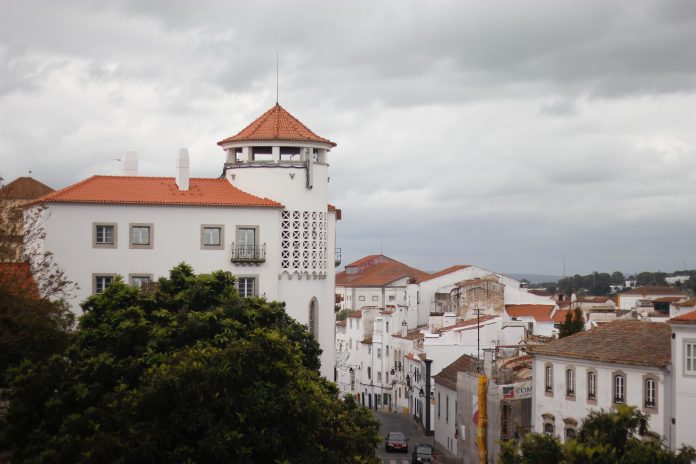
If you’re looking for a getaway and a good starting point to see the Alentejo , then the historic capital of the region is the best place to go! Évora, considered the Portuguese city with the second-best living conditions, is around 1,300 sq km (or about 500 sq mi) and has around 50,000 people.
Competing with Braga in seniority, the city has a history dating back more than five millennia. In Évora, you can travel to the different times that the city has lived through, from the Romans, passing through the times of the Inquisition until the 1900s. It’s generations and generations of different types of people and cultures that have walked that same ground! Many of them, even the same cobbled streets as we are walking!
Its Historical Center was the second one in Portugal to be considered a UNESCO World Heritage Site and is fairly quick to see, with 1.05 km 2 (0.41 sq mi). There you can find amazing buildings like the Roman Temple, the Évora Cathedral, the Bones Chapel, the Aqueduct, and over 400 historical buildings in this incredible walled city.
The typical Portuguese sidewalk (“Calçada Portuguesa”) fills the streets of this time-traveling city. On each side of its narrow streets, you will find houses that tell history in each of their stones.
Once the residence of kings, this museum-city will take you on a journey through space and time, with its historic scenery and its monuments that inspired Brazilian architecture.
Getting to Évora
Lisbon to évora.
You should drive 140 km east out of Lisbon along the A6 highway, in the direction to Évora. This will take you around 1:30h. Or you can hire a Tesla to drive you and give you a tour.
You can also get there by bus, with Rede Expressos having daily buses to Évora from Sete Rios.
As for the trains, there are Lisbon-Évora rides four times a day out of Oriente, Sete Rios, and Entrecampos railway stations. However, Évora’s railway station is 1km south of the city center, about 20 minutes by walking.
Porto to Évora
This will be a loooong drive from Porto …
The quickest route is through the A1 and A6 motorways (around 410 km). This, with good traffic, takes around 4 hours!
As for bus and train, you should first get to Lisbon and then change the bus or train to the ones going to Évora.
How to Plan Your Visit
Day Trip to Évora from Lisbon: You can make this a day trip from Lisbon and explore the city in a day. Most of the interesting places are in the Historic Center and you can get to them pretty fast, but probably you won’t have that much time to explore the surroundings.
Stay in Évora and explore the surroundings: Explore the beautiful city and the rest of Alentejo! Head on to the Great Lake of Alqueva, the wonderful Beja, founded by Emperor Julius Caeser himself, to Elvas, the largest walled city in the world, or to Évoramonte, where you will find an amazing castle with a peculiar architectural feature! You can also visit Vila Viçosa or Viana do Alentejo, two beautiful Alentejan towns, or even go to the Spanish city of Badajoz or Mérida. And if you are a political fun facts aficionado, you can head on to Olivença/Olivenza, a town on the border that is claimed by both Portugal and Spain.
Where to eat in Évora
At Praça do Giraldo you will find lots of restaurants to choose from with regional traditional cuisine! The main dishes you can find in the city are tomato soup, purslane (‘beldroegas’), ‘toucinho’ (a type of bacon), dogfish, ‘açorda’ (a traditional bread soup), and the well-known convent sweets. In many bakeries, you can also find the famous ‘Queijada de Évora’ or the ‘grala bread’, try it out!
If you are looking for more modern and different food from the traditional, then head on to Alcárcova de Baixo Street, one of the ‘trendiest’ streets in the city.
Nightlife in Évora
You will find some cafés and bars open at night, where you can have a coffee or a drink. If you feel like it, you can even find some nightclubs (as a student city too, Évora has to have places to party!).
Besides all of this, you can have a quiet walk around the Historic Center, watching the lights illuminating the historic houses, churches, and the Temple. Alentejo is the hottest part of Portugal, and even though it gets colder at night in the colder months, you can have a comfortable walk if you take a good jacket.
What to do in Evora
It is usually joked that in Évora, every kick on a rock will reveal an archeological treasure, due to its millennia of human history. And you will experience this if you visit it!
Book Tours & Experiences in Evora
Here are the main attractions that you HAVE to see in Évora:
Praça do Giraldo
This square is the living heart of the city. Under the hot Alentejan sun, you will see the locals resting on a bench there or next to the water fountain. Wonderful archways and the typical Alentjean white walls (to reflect the sunlight and not absorb it) surround this central square, giving it the authentic and traditional look of the region.
You can find a very bustling market there on the weekends, and on the other days, you can shop in the several stores under the archways. In the summertime, the restaurants in the square will have some tables outside and you will see the square filled with life, with families having lunch and people having coffee and chatting. You can also find some music concerts or street theaters happening in the square if you are lucky!
The square is said to have been named after Geraldo Sem-Pavor (Geraldo the Fearless), an outlaw who expelled the Moors from the city. With the passage of time, Geraldo turned to Giraldo and the name stayed, the Square of Giraldo.
Rua Cinco de Outubro
Going through the arches of the square, we reach the 5 th October Street, named after the day of the Implementation of the Republic in Portugal.
This street is filled with handicraft shops, from carved cork, by which Portugal and the Alentejo more specifically are very well-known, to copperware. It is very tourist-centered, with lots of souvenir shops, but nonetheless a must-go street! You can even find here the famous Queijadas de Évora that I’ve talked about eating!
You can also see living houses with the neighbors talking to each other in the windows while letting the airflow through the house (the heat is not to joke about here!).
Sé Catedral de Évora
The Cathedral of Évora is one of the most majestic Cathedrals that make up the Portuguese religious patrimony and the largest medieval Cathedral in Portugal.
The building is of Romanesque origin, as it was built in this style in 1204, but through the ages, it faced several changes. Now, it has traces of various other architectural styles, such as Plateresque, Gothic, or Baroque.
On the main door, you can see a wonderful 14th-century sculpture of the Apostles, before walking inside, and seeing it is as wonderful as outside.
You can also visit the sacred art museum inside and its terrace, where you will have a privileged view of the city from its high towers.
Templo Romano de Évora
Also called “Diana’s Temple” (even though this was then found out to be wrong) the Roman Temple is one of the most emblematic monuments in all of Portugal, considered one of the most important legacies left in the two millennia of Roman history in the region.
It is believed to have been built in the 1 st century AD, its surviving columns have survived over 2.000 years, being themselves a monument of masonry.
In that same square, you will also find the Jardim Diana (Diana Garden), with its romantic flowers as if they are watching over the Temple, and the Évora Museum, a former 16th-century palace that houses the entirety of the city’s history under its roof. At night, the temple is lightened, filling it with an even bigger sense of grandiosity.
Termas Romanas de Évora
The Roman Baths were the place where people would bathe, hang out, and make business. Now, it is part of the rich legacy of this city, as a former Roman city.
Dating back to the 1 st century AD, these Baths were very recently discovered, only in 1987, when some excavations were being made in the old part of the Hall. It is complete with a brick doorway, a sunken room with a circular steam bath, vestiges of a furnace (that was used as a central heating system), and an open-air swimming pool.
Situated inside of what is now the City Hall, the Roman Baths can be visited for free, from Monday to Friday during office hours.
Palácio Cadaval
The Cadaval Palace incorporates parts of the city’s old castle and the Lóios Church or Church of Saint John the Evangelist.
This Church’s modest exterior does not do justice to its inside. Completely filled with 18th-century azulejos depicting the life of Saint Lawrence, this will leave you in constant awe throughout your visit.
The Church also holds a secret. It was built on top of the ruins of a Moorish castle, and here, on the cistern of this castle, a crypt was made to house the bones of the friars of the Lóios Convent. You can access it through a trapdoor among the benches. If it’s locked, just ask the Church’s caretaker to open it up!
Today, besides the Church, it features a patio, where you can enjoy a relaxing coffee, a luxurious Inn and a restaurant, as well as the famous Tower of the Five Corners, said to be haunted. It is still a private residence, where you can see the valuable Cadaval family collection of paintings, manuscripts, sculptures, armor, and weaponry from the 15 th until the 18 th centuries.
Mercado Municipal de Évora
A symbol of the local economy, the Municipal Market is where life starts in Évora, with the local population rushing to the spot to get the freshest local products.
If you want to get a taste of the normal life in Évora and get traditional local products, like Alentejan cheeses or regional cakes, this is the place! You can also have a relaxed coffee or breakfast in its cafés while talking to the locals, or even an ice cream at the ice cream shop.
It is open between 7h and 18h, every day except Monday.
Igreja de São Francisco e Capela dos Ossos
The Church of St. Francis is, together with the Cathedral, one of the first things you can see when you arrive in Évora, rising out of a hill in the Alentejan plains.
This Church is made in the Gothic-Manueline style, being originally in a Romanesque one, but little is left of it. It was the first convent where the Franciscans installed themselves in Portugal, making it of big religious and historical significance.
At the end of the 15 th century, the kings started to give this, at the time, Convent more privileges, being nicknamed “the Convent of Gold”, because of all the richness that decorated it.

This 16th-century chapel also features two dangling corpses, one even being of a child.
To make it even creepier, when you enter the chapel you can find a warning saying: “Nós ossos que aqui estamos, pelos vossos esperamos” (We bones that are here, await yours). Like, really??
Even though it seems like a really creepy place, it is actually the second most visited tourist attraction in Évora. People come because of the shock that it is to see a whole building made out of what once were humans, but also for the consciousness that it gives of the frailty of life.
Today it is not that much of a creepy place, it is well lit and you have visitors coming and going, so you will be fine! So if you think you only have a stomach for one bone chapel and you’re wondering between this one and the Lóios one, I would recommend this one.
Universidade de Évora
The building of Évora’s old university is amazing. Built with sculpted marble and with walls covered in azulejos, the building itself invites you to come in. When you do that, you will get even more amazed when you see the classroom walls decorated with panels of each of the subjects taught.
You can also find an 18th-century Baroque chapel, known as ‘Sala dos Atos’. You can ask the caretaker for the key if you want to explore it!
The collection of buildings was inaugurated in 1559 and it is still used by students, so you should check with the workers there if you can explore.
Aqueduto da Água de Prata
The Aqueduct of Silver Water is so incredible that it was spoken about by the great Portuguese poet, Luís de Camões, who described it in its masterpiece “Os Lusíadas”. The structure can be seen throughout the city, going for 9km and reaching a height of 26 meters.
As it reaches closer and closer to the center of the city, the Aqueduct mixes together with the houses, shops, and warehouses that were built within its arches. You can see the traditional houses of Alentejo, painted white, light blue, or yellow, that use it as a doorway. You can find lots of them around Rua do Cano.
Definitely, a place to check!
Alto de São Bento
Overseeing the whole city, this well-kept secret has the best panoramic view of Évora. Next to the old windmills and the Museological Center, you can sit there and watch a breathtaking sunset over Évora, perhaps accompanied by your loved one, with some friends or enjoying your well-deserved alone time.
Jardim Público
The Public Garden of Évora is a great garden if you are looking for colors and plant diversity. You can enjoy a quiet time there, a wonderful picnic and, as always in this city, a bit of history. Here are the remains of the Medieval Wall, D. Manuel Palace, and the Ruínas Fingidas (or Faked Ruins, named this way because they were built in 1863 by Italian choreographer Giuseppe Cinnatti with ruins of several monuments in the city).
You are guaranteed to enjoy your walk there and, if you’re lucky, you might even find some company in the peacocks that walk around the Gardens.
Megaliths Tour
If you want to adventure a bit outside of the city, you can go on this Megaliths Tour until the Cromeleque dos Almendres (Cromlech of Almendres), an oval-shaped monolith made up of 95 granite stones that date back to the end of the 6 th millennia BC.
It is believed to have been a temple dedicated to the sun, with the circle serving as an astronomical observatory. But the mystery stays on what is the Menhir of Almendres, a 2.5 meter stone found 1.5km from the Cromlech.
You can visit the sites through a marked trail and tour them with local archeologists, to get a better understanding of what is known (and unknown) about this structure.
Book Megaliths Tour
Final Remarks
Évora is a millennia-old city that still endures in the 21 st century. Marked by the passage of the years, with history built upon history (quite literally, in the case of the Lóios Church), a visit to it is a necessary one if you are around.
If you have an interest in understanding the Alentejan way of life, the culture, the architecture, the history, and the mentality, just walk through the streets of Évora and immerse yourself in the city. Talk to the friendly people that will surely approach you, have a coffee around, eat and drink in the local ‘tascas’!
But don’t forget that it still is the capital of the region, and in the capitals, you usually can’t have quite the feeling of the rest of the region (you know, “big city” life), so be sure to see the rest of Alentejo and its beautiful towns and people.
In any way, usually, 2 days is enough to visit the historical city and the surroundings, and if you do want to visit the rest of Alentejo, Évora is a great jumping start to visit the whole region! I hope you have a chance to visit this wonderful place and I hope you enjoy it!
⬇️ What are your favorite things to do in Evora? Let us know in the comments below ⬇️
Receive the latest news, travel information, stories, offers and more!
Join our FB group Portugal Travel & Living for all things Portugal and news updates
Related articles, how to prepare for an earthquake in portugal, government reduces taxes for portugal golden visa, guide to renting in portugal, most popular, latest articles, music to help you learn european portuguese.
Portugal.com is an independently owned and operated tourism portal about Portugal. All information should be considered informational and for entertainment purposes. Some content may be promotional and/or have affiliate relationships where Portugal.com earns revenue promoting the content.
Want to advertise on Portugal.com? Would you like to write for us? Something else? Please feel free to Contact Us!
© Portugal.com
- Privacy Policy

Subscribe to our newsletter below to get the latest news, reviews, info and more!
Thanks, I’m not interested

Things To Do in Evora, Portugal: Visiting Portugal’s Museum City

Exploring all the things to do in Evora, Portugal is like taking a trip back in time. In fact, it’s often called Portugal’s “Museum City” because of its preserved architecture. Evora is a UNESCO World Heritage Site, thanks to more than 2,000 years of history plus an escape from damage in the 1755 earthquake that nearly leveled Lisbon.
History-lovers will be drawn to Evora’s Roman temple and aqueduct, as well as a medieval cathedral complete with a bone chapel ossuary . Did I mention that it also has Celtic megaliths older than Stonehenge?
Later architecture from Evora’s Renaissance includes palaces, churches, convents and a city square.
But some of the most recognizable and charming features of Evora are its everyday spaces. Low houses line the narrow city streets, painted in bright white and ochre yellow, with terracotta roofs and wrought-iron balconies.
Many people visit Evora as a day trip from Lisbon, but I absolutely recommend staying a few days here. There’s much to explore in the city, as well as day trips in the surrounding area to visit megalithic stones, medieval castles, and local wineries.
It also makes a great stopover on your way to the Algarve beaches . In this guide, I’ll share the best things to do in Evora, Portugal: what to see, where to stay, and why Evora definitely belongs on your Portugal itinerary!

This article contains affiliate links. If you click through and make a purchase, I might earn a commission, at no additional cost to you. Thanks for your support in this way! Learn more in my Disclosure Policy .
In this Guide to Evora, Portugal
Getting to Evora | Top Evora Hotels | Evora History | Things to Do in Evora | Evora Restaurants | More Evora Portugal Hotels
How to get to Evora
Evora is in the Alentejo region of Portugal, an area rich in vineyards, farmlands, hilltop castles and beautiful coastlines. There are so many things to do in Evora, Portugal, it deserves a 1-2 night stay rather than just a day trip.
If you drive, Evora is about an hour and a half from Lisbon. Some hotels have parking lots – be sure to ask since space is at a premium within the city walls! There is also free public parking a quick 15 minute walk from the city center.
Visiting Porto? Evora is a convenient stopover on your way to the Algarve beaches. Get tips for making the most of your time in Porto.
Buses and trains run daily between Lisbon and Evora – check route information here .
If your time is limited, you can also visit Evora on a day trip from Lisbon.
Read next: Things to Do in Obidos, Portugal: Visiting “The Queen’s Present”
Where to Stay in Evora
One of the best reasons to spend a few days in Evora is for the chance to stay at a historic hotel within the city walls. I’ll share my top recommended Evora hotels so you can understand my excitement about this, then I’ll include a longer list of Evora hotels at the end of this guide.
Keep in mind that at many pousadas, you can stop in for a drink or coffee to see the public areas of a hotel, even if you aren’t staying there.
Pousada Convento de Evora | Top Evora Hotel
The Pousada Convento de Evora is located in the center of the old city, and overlooks the Roman Temple and Cathedral. The guest rooms are the carefully-renovated convent of the former Lóios monks, and many original features like arched halls and vaulted ceilings were preserved. Parking is available here, plus a pool and onsite restaurant.

Click to see more photos, prices, and availability ⫸
Albergaria Do Calvario | Recommended Evora Hotel
Located within the old city walls in a 16th-century olive oil mill, the Albergaria Do Calvario is a few minutes’ walk from the main sights of Evora. Bright rooms, tasty breakfast, and parking available.

The Noble House | Charming Historic Evora Hotel
Centrally located within the old city, the Noble House includes traditional architectural features, bright spaces and comfy rooms. Limited parking is available, and spring for a suite or upgraded room to be sure you’re in the main hotel, where the WiFi signal is stronger. I stayed here, and loved the location and breakfast, but wish I’d booked earlier to get a room with a view.

Evora, Portugal Vacation Rentals
Looking for more than just a room in Evora? Check out these recommended Evora rentals in the city center and surrounding region.
Evora, Portugal History
Evora, first known as Ebora, was settled more than 2,000 years ago by Celtic tribes. Outside of the city, megaliths older than Stonehenge remain, known as the Almendres Cromlech.
Romans conquered the town in 57 BC and expanded it into a walled city; ruins from this time include a temple, aqueduct and city baths.
Evora later fell under Visigoth rule, until being conquered and ruled by Moors from 715 – 1165. Evora was retaken from the Moors by Geraldo the Fearless, who became a symbol of the city, including its coat of arms. He also lent his name to the city square, Praça do Giraldo.
During its Renaissance years, Évora was a favorite location of Portuguese kings, and many sights remain from these golden years including palaces, churches and convents.
The city became a center of learning; the Jesuits formed a university in 1559 until being expelled in 1759. The University of Evora eventually reopened, nearly 200 years later.
The historic center of Evora has retained its history and charms, while the city has expanded outside its original walls. There is a large student population here; I nearly mistook them from Hogwarts’ students in their black capes!

Things to Do in Evora, Portugal
You can see all the things to do in Evora by foot within a day, but I’ve added on some day trips at the end of this section in case you have more time. Some sights like the Cathedral are closed for the lunch hours of 12-2pm; be sure to check opening hours.
I’ve also marked the best things to do in Evora on the map below.
Silver Water Aqueduct (Aqueduto de Agua da Prata)
There are actually two parts to Evora’s aqueduct system: traces of an old Roman aqueduct, and a newer aqueduct commissioned in 1531 by King Joao III. It was designed by a military architect, Francisco de Arruda, also known for designing the Torre de Belém in Lisbon.
Evora’s aqueduct is visible as you approach the city. But as you walk Evora’s streets, you’ll also see houses and shops built within its arches as it descends to the main square.
Look for this around the Travessa das Nunes, which I’ve marked on the map.

Roman Temple of Evora, or Temple of Diana (Templo Romano de Évora)
People can’t seem to agree if this temple is dedicated to the Goddess Diana, but its Roman origin of the 1st century AD isn’t in doubt. In any case, it’s a must-see in Evora!
The temple’s ruins are mainly Corinthian stone columns on a base. Located in the center of Evora at its highest point, there’s also a small park here (Jardim de Diana) and an outdoor cafe overlooking the city.

Cathedral of Évora ( Sé de Évora) | Top Things to Do in Evora
Evora’s cathedral (or sé ) is the largest medieval cathedral in Portugal. Located near the Roman Temple, the cathedral has massive towers, a cloister, chapels, rose window, and cathedral museum with religious art.
Climb up the bell tower spiral steps to a rooftop terrace with views of the surrounding countryside.

San Francisco Church (Igreja de São Francisco) & Bone Chapel (Capela dos Ossos)
Built between 1475 and 1550, the San Francisco Church has a large porch with arches of different styles. Inside, there’s a main nave, plus a dozen chapels of Baroque woodwork.
But the real star of the San Francisco Church is its separate Bone Chapel, with a small entrance just to the right of the church.
In this chapel, thousands of human bones line the walls, the work of monks who wanted local residents to mediate on materialism and the inevitability of death. An inscription above the chapel translates as: “We bones in here wait for yours to join us.” (“ Nós ossos que aqui estamos pelos vossos esperamos .”)
The Bone Chapel is one of the best things to do in Evora, so be sure plan it in your itinerary! Also included in the Bone Chapel admission price, don’t miss the museum upstairs (Núcleo Museológico) which includes religious art and a large exhibit of nativity sets from around the world. I loved this because I have my own collection of world nativities !
Check out my detailed guide to visiting the San Francisco Church, including the Evora Chapel of Bones and world nativity exhibit .

Giraldo Square (Praça do Giraldo)
Evora’s main square has shops, open-air cafes and restaurants, and a large Baroque fountain. There’s a tourist office here, and it’s an excellent place for a coffee or meal on your list of must-see Evora sights.

Roman Baths Ruins
Discovered beneath the Evora City Hall, you can check the remains of ancient Roman baths during opening hours for free. If you’re interested in treating yourself to a reimagined Roman bath experience, check out the nearby In Acqua Veritas spa .
Evora University (Universidade de Évora, Colégio do Espírito Santo)
Established in 1559, this university has several buildings, the most picturesque of which is the Colégio do Espírito Santo. The building has a square plan around a grand cloister, known as Pátio dos Gerais, with a center fountain. Visitors can explore the halls decorated with tiles and artwork.

Evora Museums | Top Things to Do in Evora
Evora has several museums, including the Museum of Evora, which faces the Roman Temple. The museum is small, but has medieval, Roman and modern pieces in its collection. The Cathedral and San Francisco Church both have museum collections with religious art.
More Evora Churches
As you walk through Evora, you’ll encounter many smaller churches. Several are lined with beautiful azulejo tile, like the Igreja de São João Evangelista that faces the Roman Temple.
I especially liked the Igreja da Misericórdia, which was just down the street from my hotel, The Nobel House. The church and convent Nossa Senhora da Graça or Igreja da Graça has an interesting facade, but isn’t often open, so I wouldn’t go out of my way for it.

Evora Megaliths: Almendra Cromlech and others | Top Things to Do in Evora
Everyone has heard of Stonehenge; but until I visited Evora, I had never heard of Almendra Cromlech – which is actually 2,000 years older! It’s believed that these stones either had a ceremonial purpose or functioned as a primitive astronomical observatory.
To get here, you’ll need a car or a tour, since public transit isn’t available.

Wine Tasting | Things to Do in Evora
Stop by the wine tasting room of the Wine Route of Alentejo in the old city center. Here you can learn more about the region’s wineries and book tours.
The Cartuxa winery just outside of Evora has daily tastings of wine and olive oil . Contact them to make a reservation and confirm a tour in English.
Visit here for more information on wines of Alentejo .
Evora Walking Tours
If you’d like to have a guide for a tour of Evora, check out this option here .

Evora Restaurants & Cuisine
Evora has a varied food scene, from hearty, rustic meals to fine dining. Keep in mind that most Portuguese restaurants charge for the couvert course.
The couvert course includes appetizers placed on the table at the start of the meal, including bread, olives, sardine paste, butter, etc. It’s usually only a few Euros each per person, but don’t be surprised to see it on your bill unless you say “não obrigado” (no thank you) and refuse it.
Alentejo traditional cuisine is based on pork, lamb, olive oil and bread. Pork known as porco preto (black pork, or Iberico pork in Spain) is one of the most renowned ingredients.
Other popular local dishes include dogfish soup, bread soup, migas, local cheese, and queijadas (cheese pastries).
For local flavors at reasonable prices, check out Taberna Tipica Quarta Feira , Restaurante O Templo , Botequim da Mouraria , or Salsa Verde (vegetarian).
For fine dining, try Origens , Tasquinha d’Oliveira , Restaurante Fialho , Enoteca Cartuxa or the 5 Amendoas Restaurant at the Victoria Stone Hotel .

More Recommended Evora, Portugal Hotels
All of these recommended places to stay in Evora below are within the old city, with the exception of the last hotel.
Moov Hotel Évora
Featuring minimalist interiors, the eco-friendly Moov Hotel Evora is a budget option set in a former bullring in Évora city center.

Click to see more photos, prices, and availability ⫸
Evora Inn is a budget guest house with a great location next to Évora’s main square, Praça do Giraldo.

Casa Morgado Esporão
Located a few minutes’ walk from the Roman ruins, Casa Morgado Esporão has private apartments with a boutique feel.

Casa do Escritor
Located within the walls of the old city, Casa do Escritor in Evora has an outdoor swimming pool, a shared lounge and a garden.

M’AR De AR Aqueduto
Housed in a 16th-century palace, this 5-star boutique hotel features a beautiful chapel and dome ceilings. Overlooking the aqueducts of Évora, it has an extensive spa with an outdoor pool.

Convento do Espinheiro, Historic Hotel & Spa
If you’d like to stay at a 5-star Evora hotel in an idyllic setting, check out the Convento do Espinheiro a few miles outside the city center. The guest rooms and shared spaces are a renovated 15th-century convent, surrounded by beautiful gardens.

Best Time to Visit Evora
Summers are hot in the Alentejo region, because of its inland location. In particular, July and August can have extreme daytime highs (above 30ºC / 90ºF).
Both spring and autumn are good times to visit Evora, when spring flowers are blooming or when autumn scenery turns golden.
Are these things to do in Evora, Portugal on your itinerary yet? Pin this guide for later!
Looking for more ideas for your portugal bucket list.
Grab my guide to Tavira, my pick for where to stay in the Algarve , or see the 10 most beautiful Algarve beaches !
And don’t miss my detailed tips for visiting the Evora Chapel of Bones and world nativity museum exhibit.
Curious about the nativity sets I brought home from Portugal as souvenirs? Check out my world nativity sets collection!
Save for later or share with a friend!
I was a travel hot mess, but I got better! I kept the name and now blog my best tips for culture + adventure travel from around the globe. Follow along for travel advice, destination guides, and photography from faraway lands and at home in Washington, DC.
Travel Writer | Photographer | Licensed Drone Pilot Member, Society of American Travel Writers (SATW)
Visit Évora in Portugal: Top Things to Do, Best Time to Go and More
- Share on Facebook
- Share on LinkedIn
- Email this Page
Life in Portugal , Lifestyle and culture
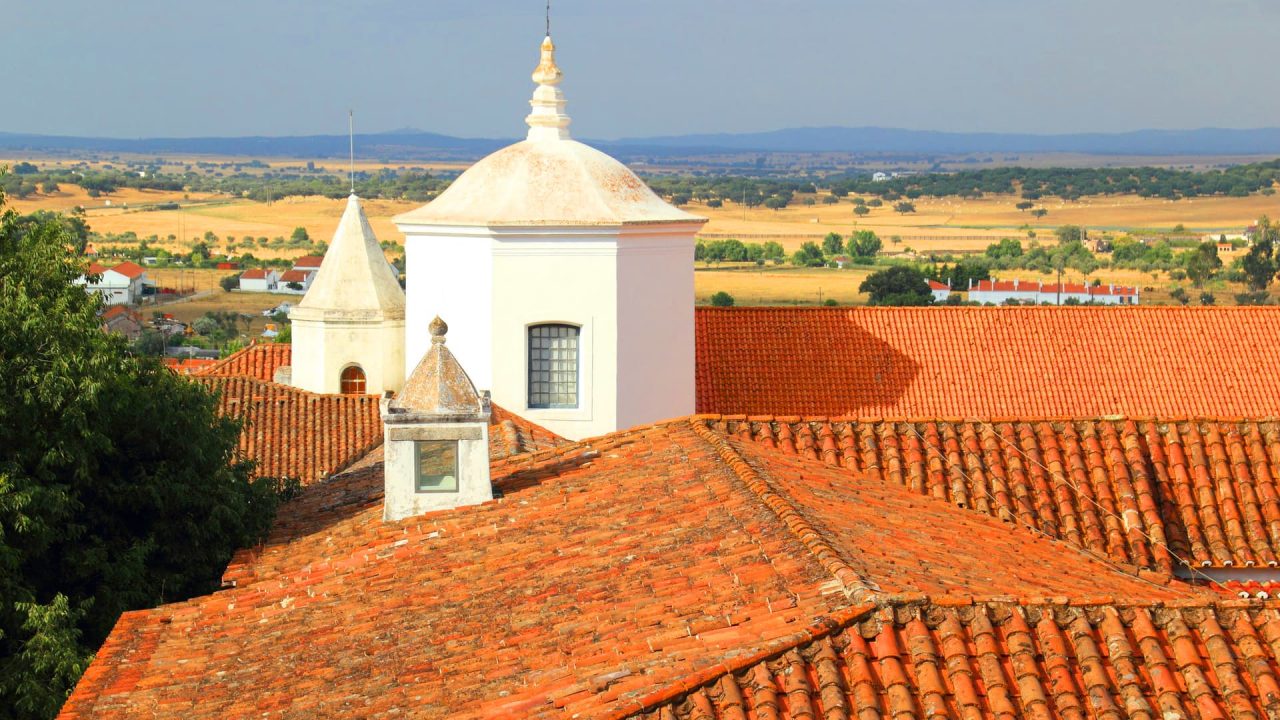
Table of Contents
- All about Évora
- Living in Évora
You may not have heard about Évora in Portugal before, but we guarantee that this is a city you will always remember. Let’s take a small ride and explore the gateway city to Portugal’s famous Alentejo region.
To visit Évora, you will be venturing into the Alentejo, a beautiful region in central Portugal renowned for its delicious food and beautiful countryside. Évora is actually the capital of this region, (Alentejo literally means “beyond Tagus”, a river which begins in Spain and meets the ocean in Lisbon). If you visit Évora, you will quickly discover why this city has become a must for those looking to unlock the true charm of Portugal. It’s a delightful small city and easy to walk around. When you visit Évora, you will have the chance to discover a vast array of fascinating historical monuments that can be appreciated by trained historians and casual sightseers alike. To visit Évora means to discover that it was historically a major trading and religious centre, a fact that is reflected in the extensive variety of tourist sites, all of which are all conveniently contained within the city’s ancient walls. Even if you’re not a history buff, you will certainly not be bored. In addition to its glorious past, the city is young and vibrant, with a large student population who attend one of the world’s oldest universities.
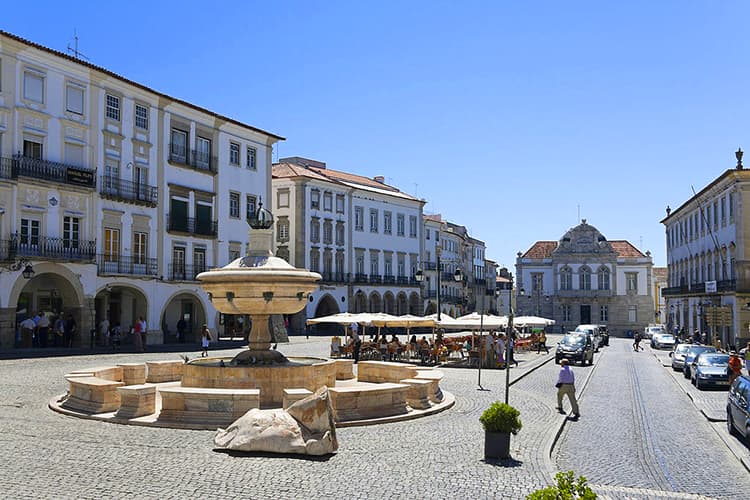
How to get to Évora
Évora is conveniently connected to Lisbon by a reliable and inexpensive public transport network that offers both rail and bus services. There are more daily bus departures than the train, but the railway has been recently upgraded and provides a more relaxing journey. Regardless of whether you choose train or bus, a trip to Évora will take around one and a half hours and the fares are comparable at €12.50 for a single adult ticket. If you’re not passing through Lisbon, it is probably better to rent a car for your visit to Évora.
Top sights in Évora
When you visit Évora, you will soon realise that there is a lot to take in. Highlights include:
- an impressive Roman temple;
- a majestic cathedral;
- intriguing prehistoric standing stones; and
- the macabre Chapel of Bones.
In terms of exploring outside the historical city walls, Évora is surrounded by sun-baked olive groves, fortified towns and traditional villages, all of which can be explored easily by car.
Roman Temple of Évora
The Roman Temple of Évora , also referred to as the Temple of Diana (“Templo de Diana”) is an ancient temple which makes a stunning impression in the historical centre of the city. It is included in the classification by UNESCO as a World Heritage Site, and no visit to Évora is complete without taking in this majestic remnant of ancient history.
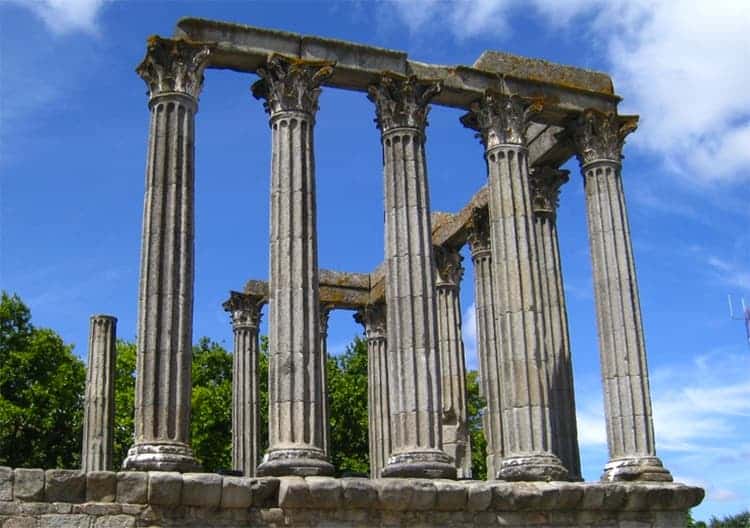
Cathedral of Évora
The Cathedral of Évora is one of the oldest and most important local monuments, perched on the highest spot of the city. It offers a breathtaking view over the historical city centre and is the seat of the Archdiocese of Évora.
Although located a bit outside of the historical city, these megaliths (website is in Portuguese) are not to be missed if you visit Évora! The concentration of megaliths around the city have given the region the title of the ‘Iberian Mesopotamia’. The area contains a diverse selection of megaliths and boasts cave-art (“arte rupeste”), dating back to the Palaeolithic period in the Cave of Escoural (“Gruta do Escoural”).
Chapel of Bones
One of the more unique sights to take in while you visit Évora, this one might leave you with chills. It is a small, interior chapel located next to the entrance of the Church of Saint Francis. The Chapel of Bones (website is in Portuguese) gets its name because the interior walls are covered and decorated with human skulls and bones. Creepy and yet very interesting, don’t you think?
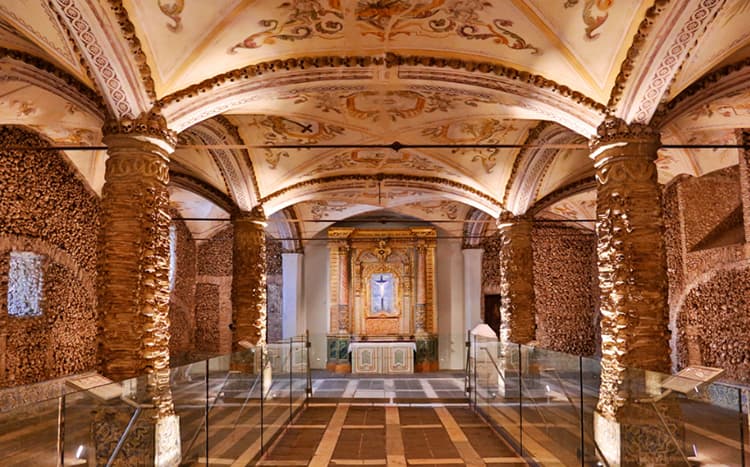
When to visit Évora
If you’re planning to visit Évora, be warned that they have incredibly hot summers, making sightseeing unpleasant for some. It is usually best to visit Évora during the warm spring or autumn months. Although the winters are typically quite mild, there is the chance of grey or wet days, so early spring is considered the best time to visit Evora. At this time, you will get to enjoy the rolling plains of Alentejo which are lush and full of flowers and the days are sunny, but not too hot.
Suggested itinerary
Although you can visit Évora as a day trip from Lisbon, it will involve a lot of travelling, especially if you are reliant on public transport. All of the major tourist sights can be seen within a day but a couple of days will you allow you to take a much more relaxed and pleasant approach. Ideally, Évora could be explored at a leisurely pace over two days, while a third day could be devoted to visiting the pre-historic standing stones of Cromeleque dos Almendres (website is in Portuguese) and the castle at Evoramonte (website is in Portuguese). We can highly recommend taking a tour with Get Your Guide to Évora and the Alentejo area. It saves you time and the hassle of driving yourself. Relax and enjoy the ride.
Where to stay in Évora
There are lots of lovely places to stay in Évora, including the historically important and beautifully luxurious Pousada Convento Évora , or the more budget friendly, yet nevertheless charming Stay Hotel Évora Centro . Another exciting way to visit Évora, is to explore the variety of guest houses or agritourism available. For example, Quinta da Tapada de São Pedro has self-catering accommodation in a lovely traditional farmhouse near the old city. On this unique, farm property, you will find extensive gardens, ancient olive trees, a swimming pool and barbecue facilities. You’ll also be in the company of sheep, goats, pigs and hens, and a you can divulge in a range of fruits, herbs and vegetables.
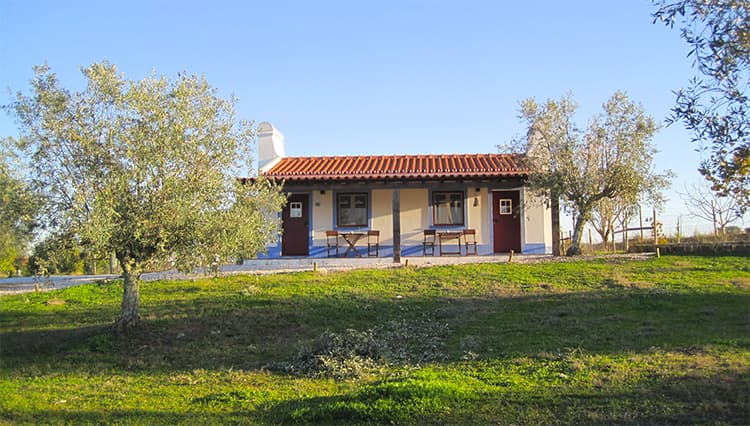
Where to eat in Évora
As you’ll quickly discover when you visit Évora, Alentejo cuisine is one of the richest and most original in Portugal. Born from the need to be creative by the poor, rural farmers, the natural bounty of the land easily lends itself to delicious culinary inventions. You will also find that nothing goes to waste in Alentejo cuisine. Entire animals are cooked and used fully – from the pig’s nose to its tail. You’ll find pig ears, cheeks or chicken brains on restaurants menus. It is also worth noting that Alentejo is known as the breadbasket of Portugal so you’ll find delicious artisan breads, wines, olive oil, cheese and the famous black pork.
Treat yourself: Go to Restaurante Fialho
If you’re looking for a memorable dining experience, don’t miss Restaurante Fialho . For over seven decades, the Fialho family has been dedicated to the art of hospitality in the Alentejan way, offering the best in genuine regional cuisine in Portugal and boasting an excellent wine cellar.
Local cuisine: Botequim da Mouraria
Run by a husband and wife, Botequim da Mouraria is the place to visit for impeccable personal service with good humour and absolutely fabulous food. They do the classics justice and you’ll leave feeling like a member of their family.
On a budget? Try O Templo
Not to miss if you visit Évora on a budget, Restaurante O Templo is a much-loved, local joint. Their idea was to create a family space, with good meat and Alentejo products at honest prices, and they have done just that.
For an even longer stay, Évora has the added benefit of providing great value for food and accommodation with the cost of living being significantly cheaper than Lisbon or the coastal towns. Due to its proximity to Lisbon, many expats even commute for work while enjoying the more laid-back lifestyle that Évora offers. Hardly comparable to real estate in Lisbon , in order to understand how inexpensive living in Portugal could be, look at the prices of houses for sale in the rural regions of Alentejo . We hope we have given you the inspiration to visit Évora and the Alentejo region of Portugal. It really is magnificent. Let us know what you think in the comments section below. Be sure to subscribe to our newsletter . It’s free and very informative packed with exclusive content about everything Portuguese.
Related Posts
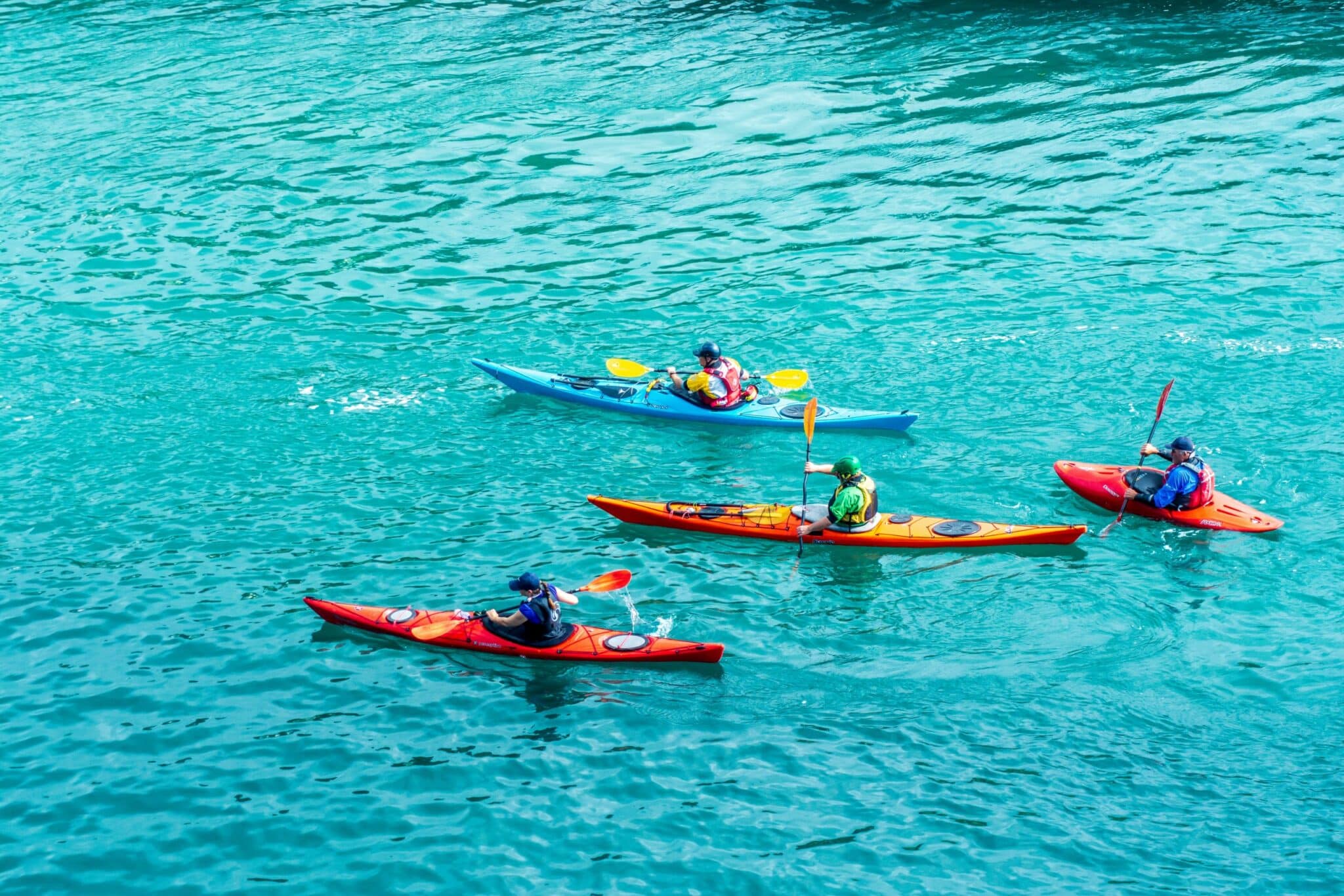
6 Amazing Places To Go Kayaking In Portugal
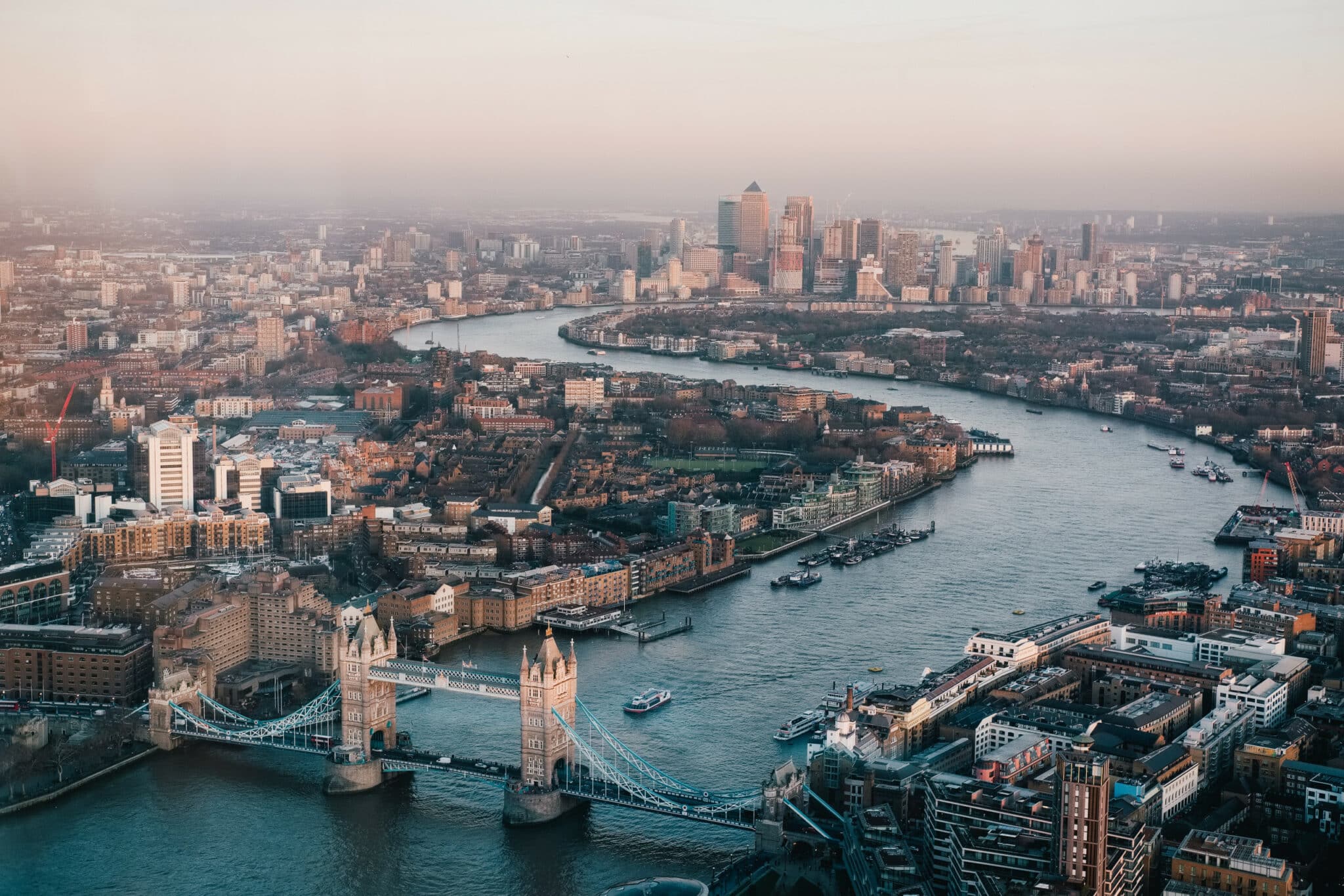
What Requirements Are There For Traveling To UK? Find Out Here
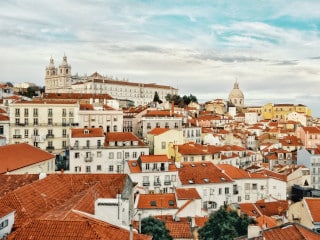
Expat-friendly Portugal ranks 12th in the Quality of Life Index

Top 7 Casinos in Portugal that Will Excite and Delight You
by Ira Fedorchak
The Azores: Flights, Hotels and Everything You Need to Visit the Islands

Stay up to date
Join our email list to receive weekly updates on webinars, promotions, announcements, social meet ups and more…
About BePortugal
Life in Portugal
Visit Portugal
Money in Portugal
Stay Connected
Keep up to date with industry insights and latest news.
Copyright © 2024 Expats Portugal
Privacy policy, terms of use.
Book your individual trip , stress-free with local travel experts
Select Month
- roughguides.com
- Travel guide
- Itineraries
- Local Experts
- Travel Advice
- Accommodation
Plan your tailor-made trip with a local expert
Book securely with money-back guarantee
Travel stress-free with local assistance and 24/7 support
Just wanted to express my thanks to Joel and Rough Guides for a wonderful trip! Everything was well-chosen and we just loved all of the hotels, sightseeing...
Évora is one of Portugal’s most historic and unspoilt cities: indeed its Roman temple, Moorish alleys, circuit of medieval walls, ensemble of sixteenth-century mansions and ochre-trimmed, whitewashed houses have resulted in its being awarded UNESCO World Heritage status. A vibrant university helps support a modern town that spreads beyond the old walls, though its current population of around 56,000 inhabitants is fewer than in medieval times, and its compact centre is easily explored within a day or two.
Things to do in Évora
Brief history, templo romano (temple of diana), around évora, travel ideas for portugal, created by local experts.

Iberian Blend - Porto and Galicia
Neighbour countries - Portugal and Spain, different and similar at the same time, will surprise you with hospitality and loveliness. This itinerary includes the route of the Northwest part of Iberian Peninsula and offers you to meet beautiful Porto and stunning Vigo in Galicia/Spain.
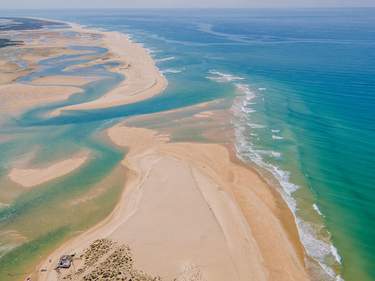
The Real Algarvian Experience
Experience and discover the real Algarve – taste local produce, drinks and traditional dishes, visit heritage sites and participate in culinary activities. If you are passionate about the people’s culture and gastronomy and want to learn more, this itinerary is for you.

A self drive to Portugal's North and Center
Starting in fascinating Lisbon, this trip allows you to discover Portugal both on your own as well as with guided tours. Driving further up north you'll explore Coimbra and Porto before heading to the Douro Valley and Alentejo.

Porto and the North of Portugal: off the beaten track
From Porto, you'll discover the most fascinating parts of Northern Portugal: go on a hike through unique biodiversity around the Paiva river, take a jeep tour through the slopes of the Serra da Arada and taste the wonderful wines of the Douro valley.

The best of Portugal: Lisbon, Porto and the Algarve
Portugal offers many highlights but when you're short on time, this trip is ideal to cover all the highlights: the capital city of Lisbon, historic Porto, lush Douro Valley and the stunning beaches of the Algarve are all part of this trip.

Azores Wild Nature
Get ready to discover what the largest island of the Azores, São Miguel, has to offer in this short adventure-packed 6-day trip. You will get to swim with wild dolphins, abseil or jump down waterfalls, ride a mountain bike through the Sete Cidades and relax in a natural spa. Adventure awaits!
Évora’s agricultural roots are recalled on the second Tuesday of each month, with a huge open-air market held in the Rossio, south of the city walls, and in the lively Mercado Municipal (closed on Mondays) on Praça 1 de Maio, where you can sample local produce – beneath the fish section is a wine cellar that offers tastings; it also hosts farmers’ markets most weekends. The town’s big annual event, the Feira de São João, takes over the city during the last ten days of June, with handicraft, gastronomic and musical festivals.
Praça do Giraldo is the city’s central hub, with the main historic kernel just to the east. Within the surrounding city walls are several distinct old-town areas, with another concentration of sights in the streets between the main square and the public gardens. Meanwhile, to the north of the centre you can follow the course of the medieval Aqueduto do Água Prata (Silver Water Aqueduct), into whose ever-rising arches a row of houses has been incorporated. Wherever you wander, nothing is more than a ten-minute walk from Praça do Giraldo.
Other sites of interest include 15th century San Francisco Church and the 13th century cathedral. There are restaurants, bars and cafes dotted all over the place so finding somewhere to wine and dine will be no issue.
The original settlement was probably founded by the Celts, but it was the Romans who fortified the city in 57 BC. Its position on trade routes allowed Évora to flourish and soon after, the Temple of Diana was erected. In 715, Tariq ibn-Ziyad began a 450-year period of Moorish rule which established the city’s maze of narrow alleys. It was recaptured by the Christians in 1165, who began to construct the cathedral in 1186 (though it was not finished until the fourteenth century). The period from 1385–1580 saw the city prosper when the royal House of Avis established their court here, and it was during this period that most of Évora’s finest buildings were built. In 1553, the Jesuits founded a highly-rated university, but this was closed down by the King’s chief minister, Pombal, in 1759; he distrusted the Jesuits’ influence. The Vauban-style defensive town walls were constructed in the seventeenth century under the French engineer Nicolas de Langres and remain little changed today. Once the Portuguese court moved nearer Lisbon, Évora drifted into relative obscurity for much of the nineteenth and twentieth centuries. However, the university was re-established in 1973 and in 1986, the town was awarded UNESCO World Heritage status as “the finest example of a city of the Golden Age of Portugal”. It is now thriving again thanks to its lively student population and as a popular tourist destination.
The graceful ruins of the Templo Romano stands at the very heart of the old city. It was built in the first or second century, supported by fourteen granite Corinthian columns, making it undoubtedly the most impressive Roman building in the country. Popularly known as the Temple of Diana (the Roman goddess of hunting), it was more probably dedicated to several Roman gods. The little square in front of the temple has an alluring kiosk-bar, while from the terrace you can look north across the rooftops – and see just how small contemporary Évora is, with the fields beginning only a few hundred metres away.
Leave at least an afternoon or two to explore Évora’s environs, which have some significant attractions. Some, like the castle at Évoramonte, warrant a quick stop en route elsewhere, though the famed carpet town of Arraiolos, just to the north, is a popular day- or overnight trip from the city. The administrative district of Évora also contains over a dozen megalithic sites – dolmens (funerary chambers), menhirs (standing stones) and stone circles – which have their origins in a culture that flourished here before spreading north as far as Brittany and Denmark. The stones of Os Almendres, in particular, provide one of the country’s most extraordinary sights. With your own car, you can easily combine a visit to Os Almendres with the dramatic dolmen of Zambujeiro. While it’s tempting to take the fast road to Beja and the south, there’s an attractive detour to be made into deepest rural Alentejo, via the small historic towns of Viana do Alentejo and Alvito. From Évora the first stop, Viana do Alentejo, is a simple twenty-minute drive down the ruler-straight N254. There’s no reliable public transport along this route – you’ll need a car.
Os Almendres
The Iberian peninsula’s largest and most impressive stone circle lies 13km west of Évora, just south of the small village of Guadalupe. To get here directly from Évora, take the N114 towards Montemor/Lisbon and follow the signs from Guadalupe. If you’re approaching from the south, from Escoural and Valverde, you need to turn left in Guadalupe, at the Café Barreiros.
You are directed out along a dirt road (largely flat and in good condition, fine for cars), reaching the Menir dos Almendres after 2km. This is a single, three-metre-high standing stone set in a quiet olive plantation five minutes’ walk from the road. Despite its obvious Neolithic origins, the local legend has it that it is the tomb of an enchanted Moorish princess, who appears once a year on the eve of São João and can be seen combing her hair.
Another 2.5km along the dirt road there’s a parking area beside the extraordinary Cromeleque dos Almendres, where no fewer than 92 stones are aligned for 70m down a dusty hillside. Placed here in several phases, between six and seven thousand years ago, they are thought to have been erected in a horseshoe shape as some kind of astronomical observatory and site of fertility rituals. Even today, the power of the site is undeniable, the stones resembling frozen figures gazing across the surrounding cork plantation to a distant Évora.
Featured Image, Evora, Portugal © Ross Helen / Shutterstock
The Rough Guides to Portugal and related travel guides
In-depth, easy-to-use travel guides filled with expert advice.
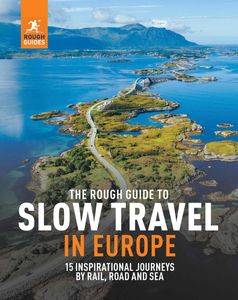
Find even more inspiration for Portugal here

Planning your own trip? Prepare for your trip
Use Rough Guides' trusted partners for great rates

written by Mani Ramaswamy
updated 26.04.2021
Ready to travel and discover Portugal?
Get support from our local experts for stress-free planning & worry-free travels.
- Where to stay
- Travel advice

COMMENTS
Evora, located in the Alentejo area of Portugal, east of Lisbon, sits on a small hill and most of Evora's main tourist attractions lie within its beautifully preserved Medieval stone walls. There is much to see and do in Evora, a city of around 57,000 people. The city's main attractions include the historic Templo Romano, the fortress-like ...
Located approximately 130km to the east of Lisbon, Évora is the largest city of the Alentejo region and its designated capital. With a history that dates to Celtic times, Évora boasts a rich historical background.
Get the free printable map of Évora Printable Tourist Map or create your own tourist map. See the best attraction in Évora Printable Tourist Map.
What's on this map We've made the ultimate tourist map of Evora, Portugal for travelers! Check out Evora's top things to do, attractions, restaurants, and major transportation hubs all in one interactive map.
As soon as you arrive in Évora, stop by the tourist office, which will give you a handy map of the best spots to take in the city's fortifications.
The Essential Travel Planner. Évora is an ancient city listed as a World Heritage Site . It's one of Portugal's top destinations for culture tourism, with architecture from different periods of history. Named "Ebora" by the Celts, it's known for one of the best-preserved Roman monuments in Iberia, and its medieval streets give an idea of ...
During my most recent trip to Portugal, I was floored to discover so many cool things to do in Evora! Here are some of the best things to do in Evora, Portugal.
Everything you need to know about visiting Évora, Portugal, the capital of Alentejo. The best things to do in Évora and more.
Bus Travel in Portugal. The bus station in Evora (tel. 266 769 410) is just off Avenida de Sao Sebastiao. Fairly frequent buses a day make the 2 hour plus journey to Lisbon. There are also bus connections to Elvas (90 minutes), Portalegre (90 minutes), Beja (90 minutes) and Faro (5 hours). Buses from Evora also connect to the small town of ...
Discovering Évora: Ultimate Travel Guide (With Map) "Embark on a transformative journey through Évora, Portugal's historic treasure, where the fusion of history, culture, and architecture invites you to wander cobblestone streets, explore ancient ruins, and indulge in culinary delights.
Detailed and high-resolution maps of Evora, Portugal for free download. Travel guide to touristic destinations, museums and architecture in Evora.
Here's how to plan the perfect trip to Évora, Portugal.
Welcome to the stunning medieval city of Evora, Portugal! The UNESCO site, and hidden treasure, sits at the heart of the rural Alentejo region. Travel through countryside full of olive groves, wide-open plains, and traditional stone villages, before reaching the city walls.
After experiencing Evora on my last trip to Portugal, there's no way I would recommend a day trip! This is a 2-day itinerary to help you explore the charming town.
Tips and Tours: How to Make the Most of Your Visit to Évora Map of Attractions & Things to Do in Évora Evora, Portugal - Climate Chart
Evora and Alentejo most complete tourist guide. Plan your Routes and Explorations. Best destinations, Food and Wine, Tours and Experiences.
The ancient walled city of Évora attracts large numbers of day-trippers thanks to its eye-catching architecture and historic centre packed with landmarks dating back centuries. The capital of Portugal's south-central Alentejo region, the city's distinctive white housesand argyle roofs account for much of its charm. But it is Évora's roots dating back to Roman times […]
Tourist guide to sightseeing in Évora, Portugal, itinerary advice, and insider tips.
Évora. If you're looking for a getaway and a good starting point to see the Alentejo, then the historic capital of the region is the best place to go! Évora, considered the Portuguese city with the second-best living conditions, is around 1,300 sq km (or about 500 sq mi) and has around 50,000 people. Competing with Braga in seniority, the ...
Exploring all the things to do in Evora, Portugal is like taking a trip back in time. In fact, it's often called Portugal's "Museum City" because of its preserved architecture. Evora is a UNESCO World Heritage Site, thanks to more than 2,000 years of history plus an escape from damage in the 1755 earthquake that nearly leveled Lisbon.
All about Évora To visit Évora, you will be venturing into the Alentejo, a beautiful region in central Portugal renowned for its delicious food and beautiful countryside. Évora is actually the capital of this region, (Alentejo literally means "beyond Tagus", a river which begins in Spain and meets the ocean in Lisbon). If you visit Évora, you will quickly discover why this city has ...
Plan your visit to Évora, Portugal: find out where to go and what to do in Évora with Rough Guides. Read about itineraries, activities, places to stay and travel essentials and get inspiration from the blog in the best guide to Évora
Europe. One of Portugal's most beautifully preserved medieval towns, Évora is an enchanting place to delve into the past. Inside the 14th-century walls, Évora's narrow, winding lanes lead to striking architectural works: an elaborate medieval cathedral and cloisters; the cinematic columns of the Templo Romano (near the intriguing Roman ...